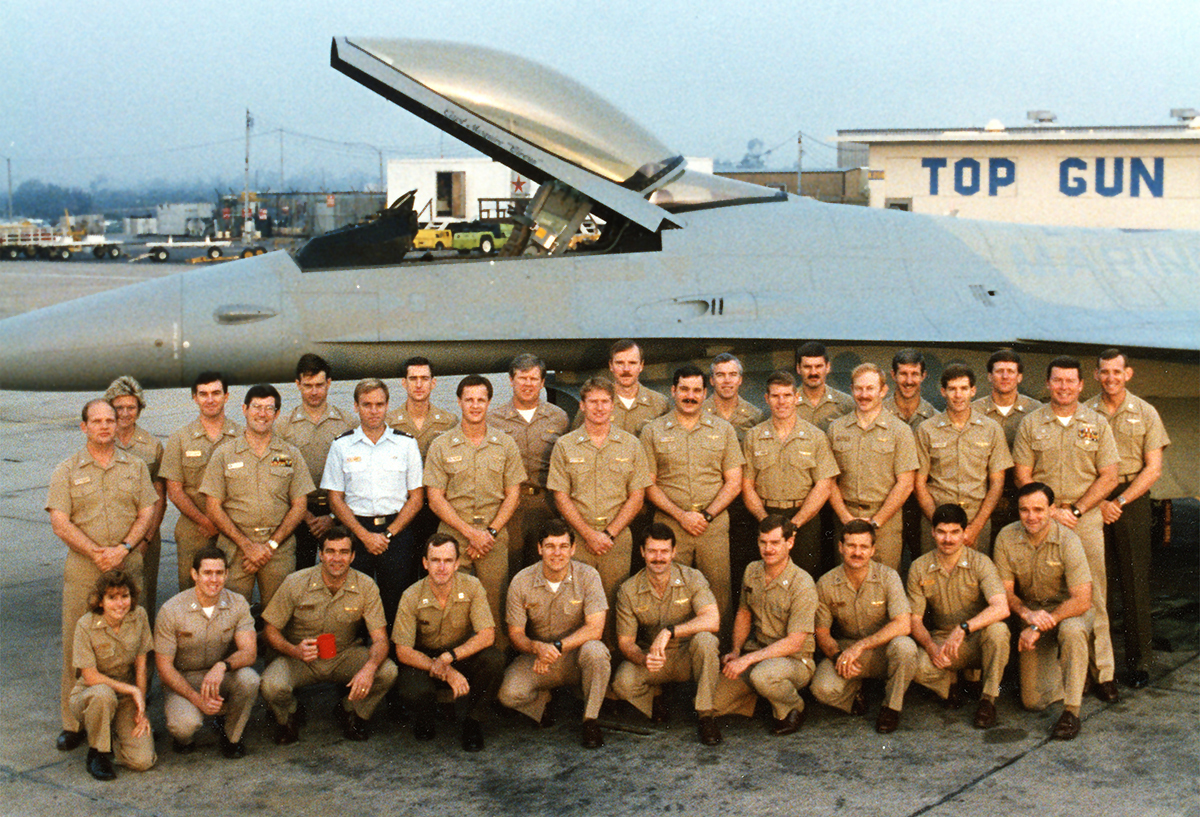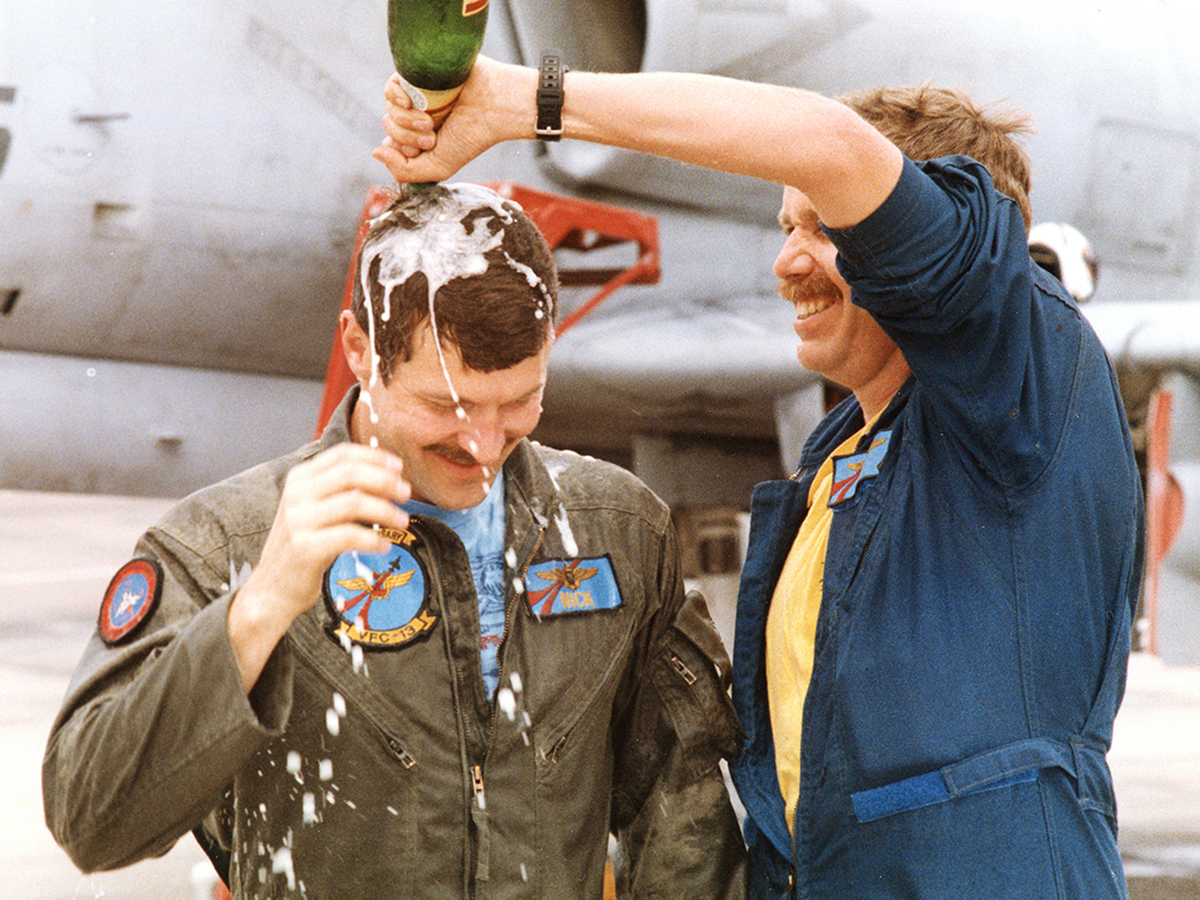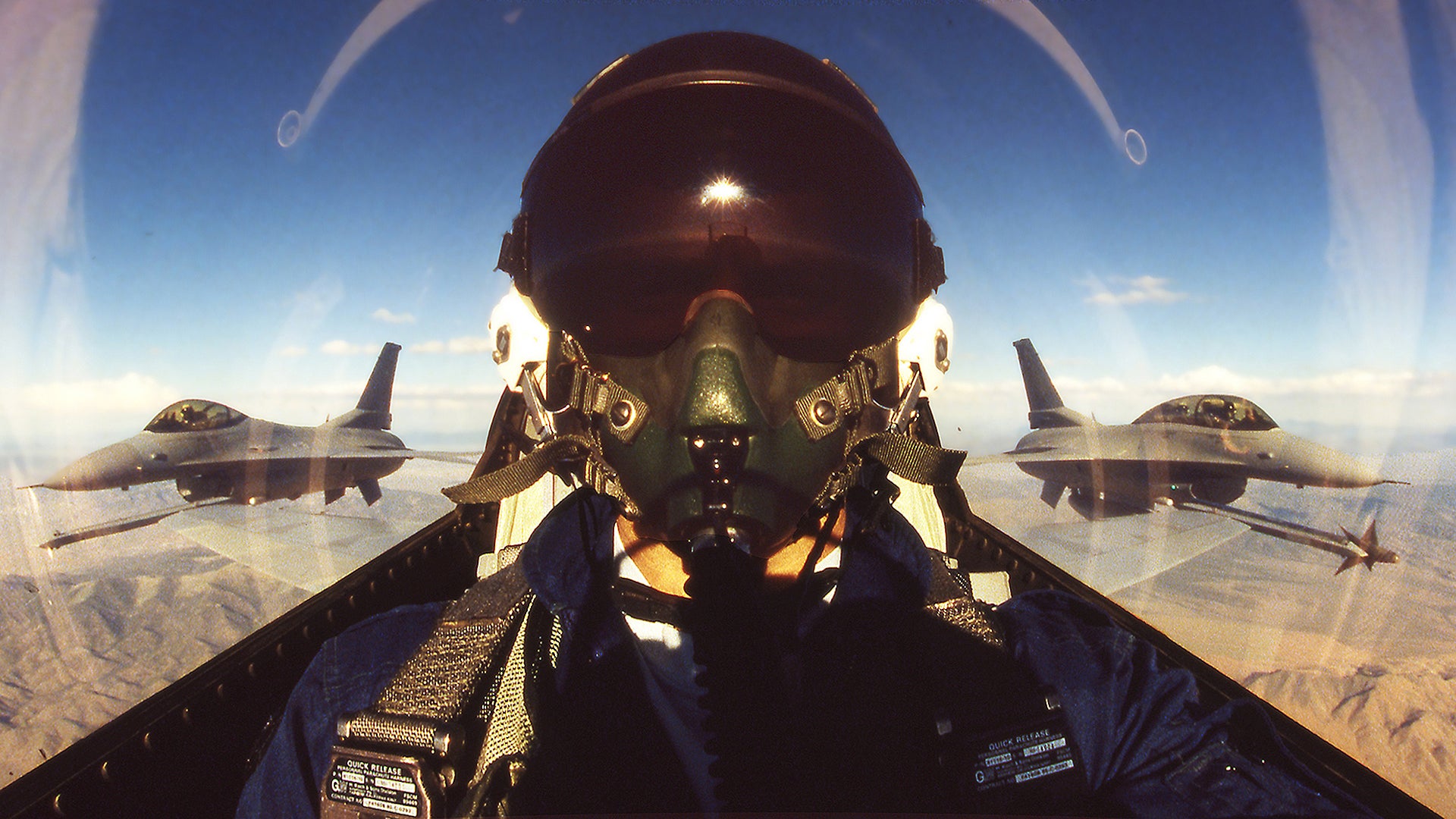In the late 1980s, F-14 Tomcat pilot and Topgun instructor Paul Nickell found himself strapping into the cockpit of a brand new Navy jet that would never land on an aircraft carrier. Instead, it was built specifically to challenge the skills of the best fighter crews the Navy had to offer. It was a stripped down, up-engined, exotically painted variant of the already nimble F-16. General Dynamics built only 26 of them, and the fleet served less than a decade before being controversially retired, but the impression the jet made was legendary.
For part one of a multi-part, in-depth series on Paul Nickell’s incredible experiences flying fighters during one of the most celebrated eras of naval aviation, here is the F-16N’s story told through the eyes of one of the small cadre of Topgun flyers that pushed it to its limits on a daily basis.
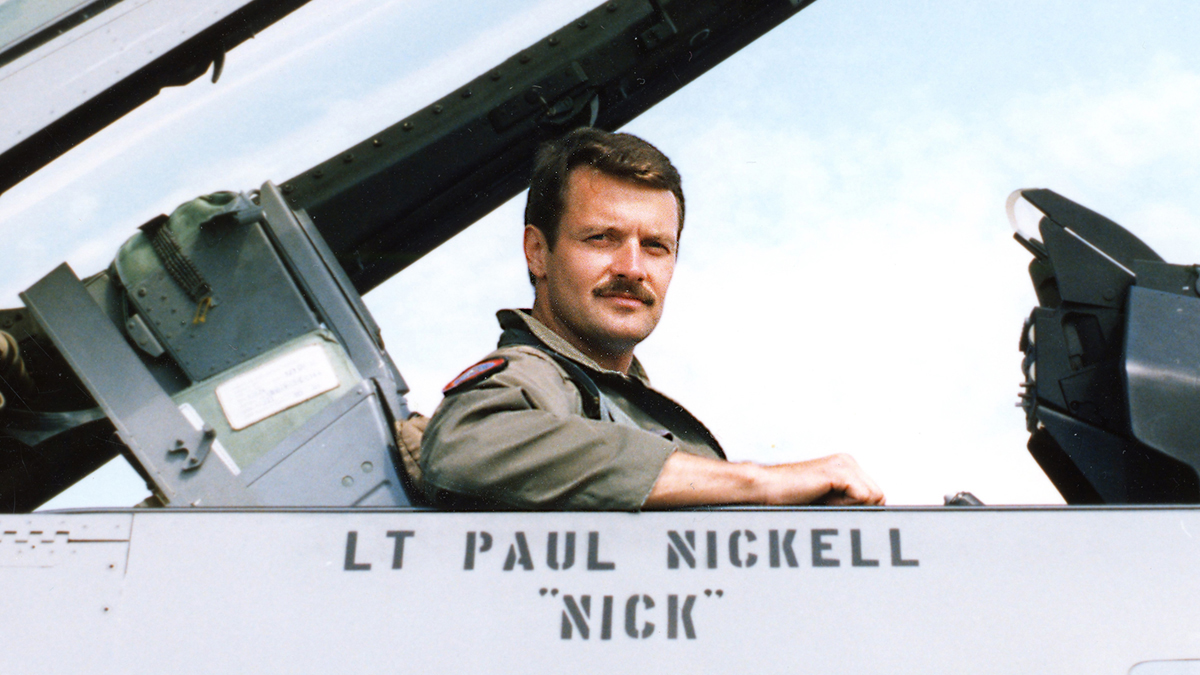
Genesis Of The F-16N
I served nine years on active duty, which meant that I never made it to DC for a Pentagon tour, fortunately. As a result, I’m not very familiar with the acquisition process for military aircraft with respect to the Pentagon and Congress. By the early to mid 1980s, it was becoming obvious that potential adversaries were fielding aircraft with greatly improved maneuvering capabilities and advanced air-to-air radars that supporti an increasingly reliable forward-quarter, head-on threat profile.
From a training standpoint, we could no longer ignore this improved capability, but it was difficult to train to the latest threat without the supporting hardware needed to emulate it. The Navy’s decision to purchase the F-16N was made in January 1985 while I was still flying Tomcats in the fleet with VF-24. Since I was not there at the time, I was not really aware of how the decision was made, nor was it mentioned much while I was at Topgun.
Interestingly, I do recall seeing an F-16 taxiing around at Miramar while I was flying F-14’s that said “F-16/79” on the side. Someone mentioned that it was a jet the Navy was looking at for an adversary aircraft, but I only recall seeing it once or twice. Having done some research myself, and also consulting a number of the Topgun contacts who were around when the decision was made, it’s quite obvious that there were a lot of politics involved, from the macro level to the micro level.
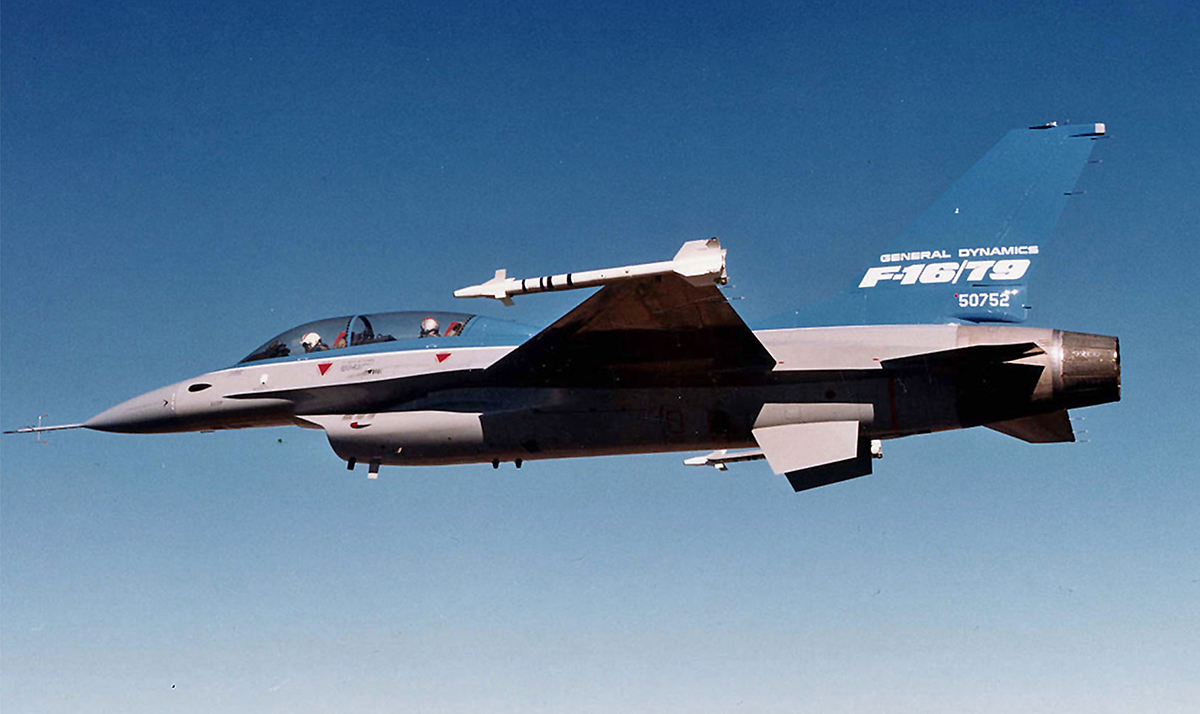
That’s not a good thing, nor a bad thing; just a reality for a decision with such far reaching implications. The following were a few of the players ultimately involved: President Jimmy Carter, President Ronald Reagan, Taiwan, China, South Korea, Pakistan, Venezuela, Turkey, Greece, US State Department, US Congress, Secretary of Defense, Northrop, General Dynamics, US Air Force, US Navy, National Guard, Navy Fighter Weapons School, and the Navy’s adversary program.
I’ll start by saying that designing and building a fourth generation fighter is an extremely expensive endeavor. The only way to sell them at an affordable price is to sell them in large quantities. There was no way that purchasing 26 aircraft for the Navy would pay for a project such as that, even if the Air Force and Marines had become involved. The only way for the Navy to obtain an affordable fourth generation adversary aircraft was to use something already in production or a variant of the same.
To further complicate the issue, you need a dissimilar aircraft to train against effectively. If you put two F-14s against two other F-14s, it works fine until the aircraft merge in mock aerial combat. After the first turn in the visual arena, it’s virtually impossible to keep track of which F-14 is your wingman and which ones are the opponents. With this in mind the Navy needed a relatively small number of dissimilar, fourth generation fighters at a cheap price. To narrow the options, according to the commanding officer of Topgun at the time, they were focused on selecting a US made aircraft. They were aware of the Israel Aircraft Industries F-21 Kfir during the selection process, however it was not a US made aircraft, and they did not believe the Navy would have entertained the idea of purchasing the Kfir for the fourth generation adversary aircraft. It was never seriously considered.
To understand the selection process, a short look at history is in order. In the late 70s the Carter administration had placed limitations on the export of front-line US fighters in an attempt to curtail the transfer of technology to the Soviets. At the same time, the US Department of Defense, seeking to make our allies stronger, encouraged the development of fighters that were capable of handling the latest Soviet threat, but without the latest and greatest in technology. Two US companies were looking for revenue in this area. Northrop, maker of the F-5E Tiger II, was looking at building upon that design to provide a viable option for Foreign Military Sales (FMS). Going through several iterations, the F-5E morphed to the F-5G as a participant in the FX program, and finally in 1982 it became the F-20 Tigershark.
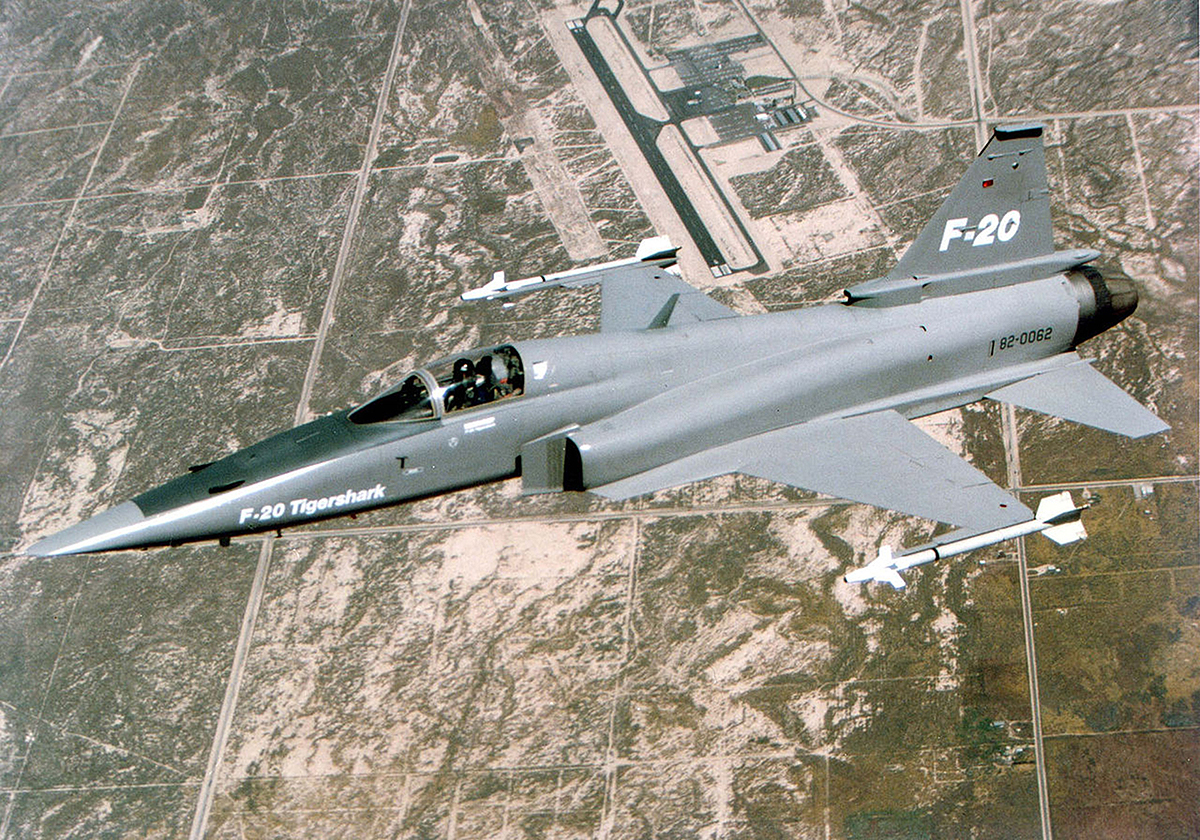
The F-20 was a very capable fourth generation fighter. At the same time, General Dynamics was looking at a way to obtain business through Foreign Military Sales for its F-16. Unlike Northrop’s problem, General Dynamics had to determine a way of dumbing down its fighter while still keeping it attractive to foreign countries. In 1979 they announced the F-16/79. It would be powered by the venerable General Electric J79 turbojet engine, the same engine that powered the F-4 Phantom and many other military aircraft of the previous couple of decades. It would be heavier and have less thrust than the F100 turbofan powered F-16A/B, and would have downgraded avionics. The selling points were a cheaper price tag and a jet that could be exported to foreign countries. However, by 1980 the Carter administration was already loosening its restrictions on foreign sales, and with the election of Ronald Reagan as president in late 1980, the restrictions would be further reduced.
By the early ‘80s the Navy had identified the need for a fourth generation adversary aircraft with a small price tag. The two readily available options were the F-16/79 and the F-20. General Dynamics brought the F-16/79 to Naval Air Station Miramar, and at least five Topgun Instructors including the CO flew the jet. They felt it was acceptable. The CO felt that the F-16N, based upon a proven, capable, and respected airframe, was a new look compared to the vintage F-5 and its follow-on F-20, and he felt that it was the best choice. Unfortunately, although Northrop allowed some instructors to fly the F-20 simulator, they were never allowed to fly the actual aircraft itself. Some thought this was because Northrop did not want to jeopardize their foreign military sales by any type of negative evaluation by the Navy.
As the Reagan administration relaxed FMS restrictions, the F-16/79 faded from the Navy’s short list for a new aggressor aircraft and was eventually replaced by the F-16N. During that same period of time the F-20 was able to be enhanced. Unfortunately in October 1984, just prior to the final decision, one of three existing F-20’s crashed and the pilot was killed. Ultimately the Navy chose the F-16N. The decision was announced in January 1985.
During the same period, the Air Force was directed to look at the F-20 Tigershark as a dissimilar aggressor aircraft. Additionally the Air National Guard looked at it as an operational aircraft. Then in May 1985 the second of the three prototype F-20s crashed and the pilot was killed. The crash happened as the F-20 team was preparing for the Paris Airshow. Both crashes were eventually attributed to G loss of consciousness (GLOC). Ultimately the decision of both the Air Force and Air National Guard was to maintain commonality by sticking with the F-16. In late 1986 the F-20 Tigershark program was cancelled.
Having spent a great deal of time researching how this decision was made, I have an even greater respect for my predecessor instructors at Topgun. As a recipient of their efforts, I was able to fly a magnificent fourth generation adversary aircraft, one that seemingly fell into my lap, yet the true recipients of their efforts were the Navy and Marine Corps aircrews who were able to train against the N. I never realized how much effort had been put forth on our behalf by a group of guys who would never get to personally reap the fruits of their labor.
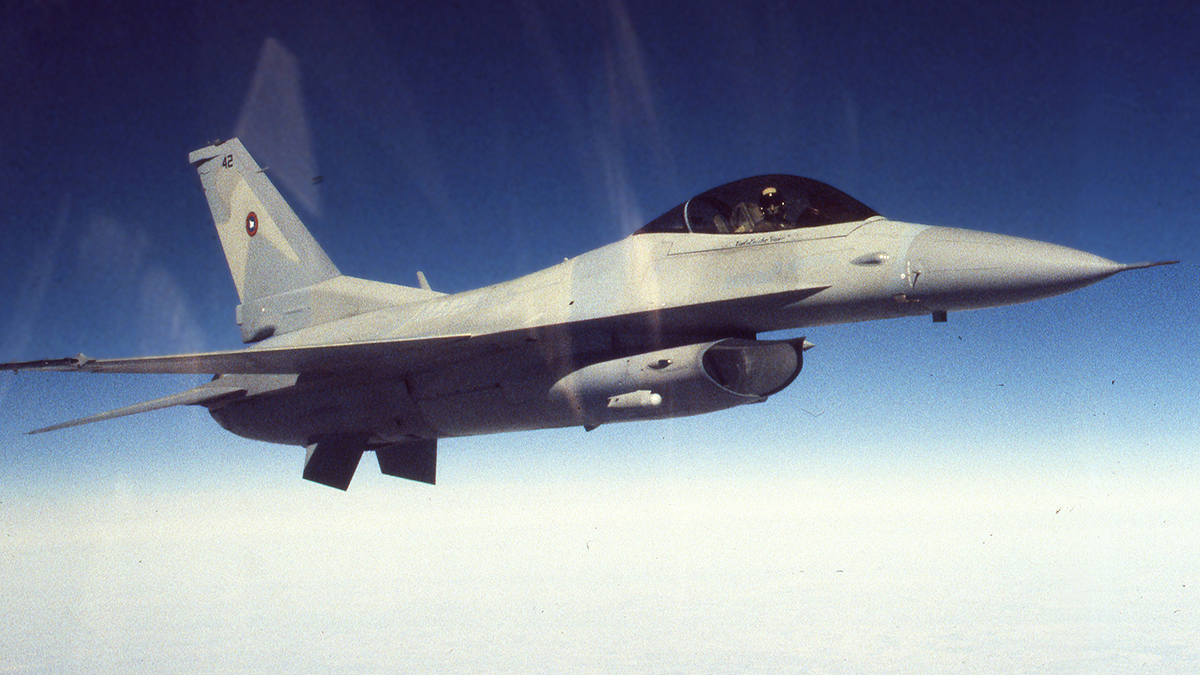
The Navy’s Hotrod Viper
The F-16N looked like an F-16C block 30 airframe, powered by the General Electric F110-GE-100 engine with 25,735 pounds of thrust in full afterburner. It normally weighed less than 25,000 pounds with full internal fuel. Later blocks of F-16s had a larger air intake, because that was apparently a limiting factor for the GE engine. With the bigger intake the engine could develop almost 29,000 pounds of thrust.
We normally flew the N with an AIM-9 Sidewinder captive training round on the left wing-tip, and an ACMI (air combat maneuvering instrumentation) pod on the right wing tip if we were going to be operating on a range equipped to support the system. Otherwise the wings were clean with no pylons to add weight and drag. We could carry a fuel tank on the cernterline belly station, but usually didn’t on the single seat models. The two-seater TF-16N Topgun had held about 1200 pounds less fuel than the single seat F-16N models, so they were flown with a centerline fuel tank at times.
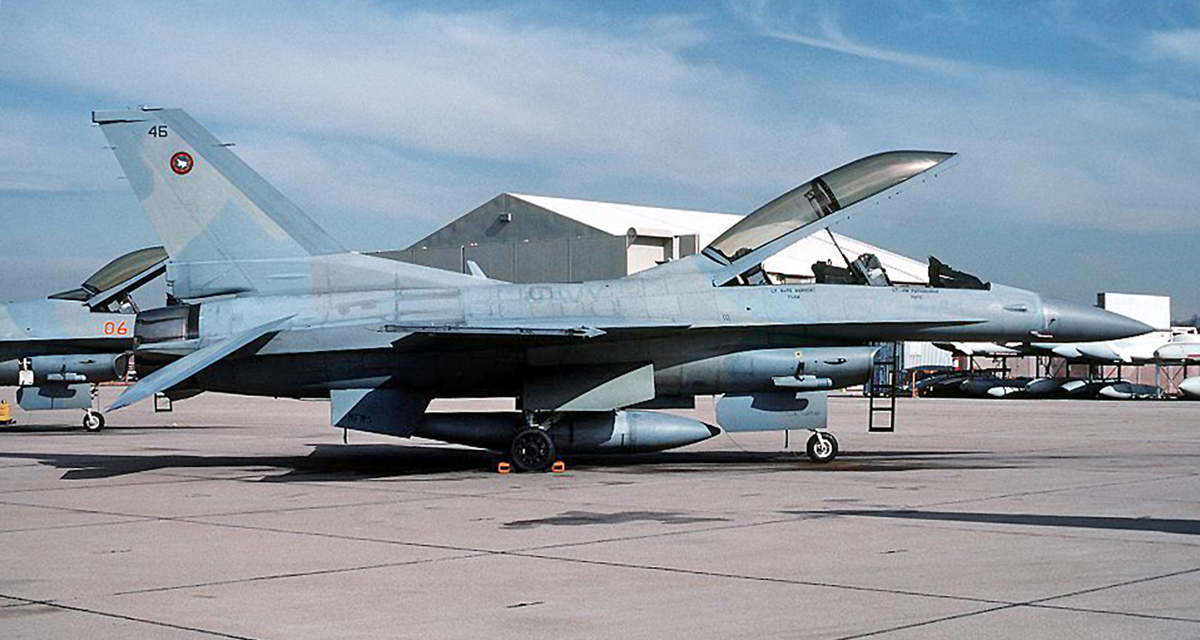
The F-16N’s radar was the APG-66 from the standard F-16A/B model. My feeling was that this was done to keep the price down. The APG-66 radar was adequate for the missions that we conducted, however I was never exposed to the more advanced APG-68 radar from the C/D model to determine all of the differences. I know that the APG-68 did have a Track While Scan (TWS) capability and the APG-66 did not.
The F-16N had no gun. Consequently Topgun gun dets (detachments away from their home base for gunnery practice) came to an end as the F-5 departed the inventory. The lack of the cannon eliminated approximately 250 pounds of weight, plus the weight of the ammunition storage and feed system. It left a fairly large compartment on top of the left side of the fuselage where we could throw a gear bag when going on any type of overnight mission. Because of the removal of the gun, some ballast weight had to be placed in the forward part of the fuselage to keep the aircraft center of gravity within limits. The HUD still displayed a Lead Computing Optical System (LCOS) gun sight, and we could select “GUN” and simulate gun shots, there was just no physical gun in the jet. Additionally there was no Airborne Self Protection Jammer (ASPJ) since the aircraft would not be flown in a true hostile environment.
Unlike the F-14, the Viper had no noticeable reduction in acceleration as you approached Mach 1. Bottom line, it was sleek and it was fast. I’ve personally seen it achieve Mach two.
Another great training asset that came with the jet was an audio/video recording system for the radar display and HUD. It definitely made recall of engagements much easier and really steepened the learning curve. Finally, the lower wing attach fittings of the jet were manufactured out of titanium, assuming that the aircraft would experience more high-G maneuvering based upon the mission it would be used for by the Navy.
One thing that we had to be careful about was the fact that the jet would do supersonic cruise (supercruise) in the configuration that we flew it. Generally slick, at altitude it could go supersonic with no afterburner with the help of its powerful General Electric engine. This was something we had to keep in mind transiting around the country. Unlike the F-14, there was not a noticeable reduction in acceleration as you approached Mach 1. Bottom line, it was sleek and it was fast. I’ve personally seen it achieving Mach two.
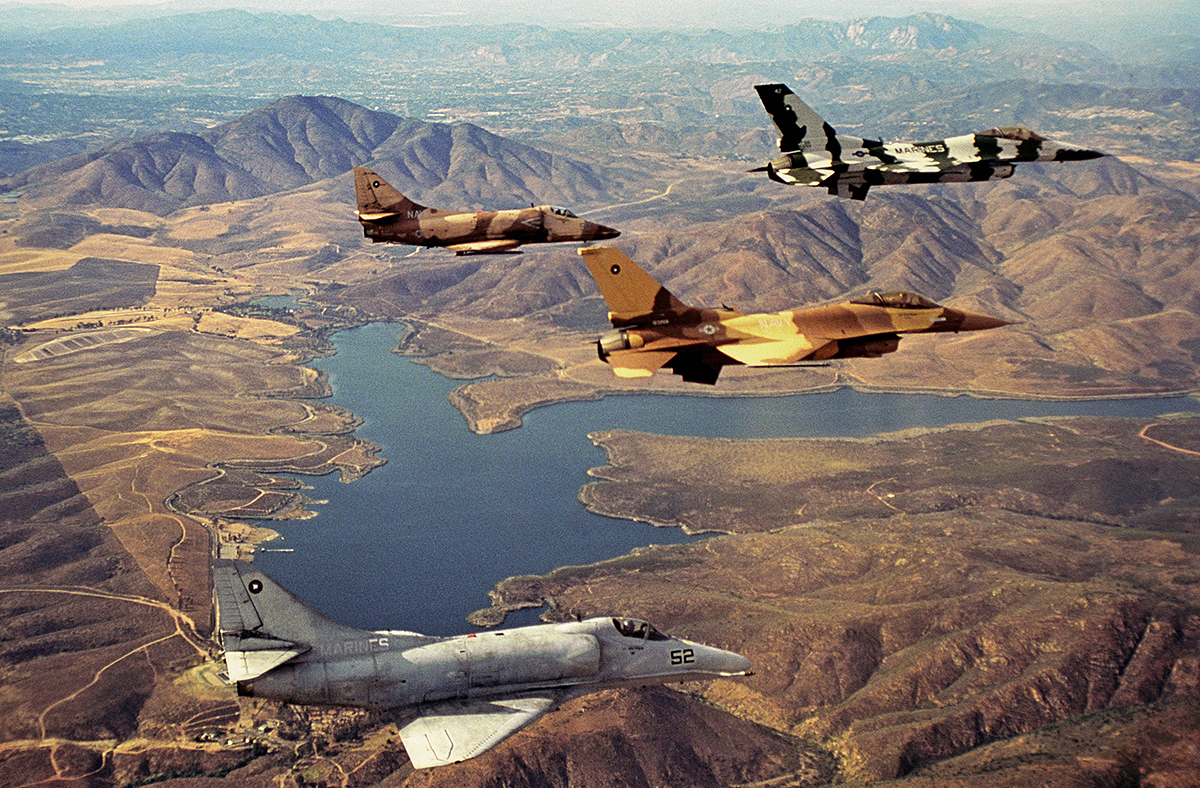
The “N” Versus Its Predecessors
North thirty two fifty two six, west one one seven zero seven six; numbers that are indelibly etched in my brain. Throw them into your “maps” app and you’ll find yourself located on the old Topgun ramp at Naval Air Station Miramar. That’s where I was standing on the 17th of June, 1987 when the Topgun Commanding Officer and Training officer flew the first two Topgun F-16Ns into Miramar. Having programmed those numbers into the inertial navigation system (INS) so many times, after almost thirty years, they’re stuck in my brain.
Adding the F-16N to Topgun and the Navy’s adversary inventory was a huge step forward for Navy fighter tactical training. Although the A-4 and F-5 had their limitations, it’s amazing what they had been capable of when employed well. But the times, they were a changin’! If you asked me to pick my favorite of the three, I would be hard pressed to give you a definitive answer. They each had their qualities and quirks. I loved flying all of them, and for a period of about 3 months during the transition, we were able to do just that. Then the F-5’s departed, and it was sad to see it go.
From a standpoint of transitioning the squadron pilots over to the F-16N, there were definite challenges. We had about 15 pilots at any time, and we were attempting to transition to the F-16N between Topgun classes, usually about a six week break. A group of six pilots departed near the end of a class and went to Luke Air Force Base for a month of Air Force training which would include ground school, simulators, and two flights in F-16Ds with Pratt and Whitney engines. The plan was that the remainder of us would go to a week of ground school at General Dynamics (at the time the manufacturer of the F-16) and then return and fly our first flight in the N with one of the qualified pilots in a chase aircraft.
Once the Topgun class concluded the remaining nine of us headed to Fort Worth for the General Dynamics training. The Navy had purchased 26 F-16s, however the two seaters would be the last four airframes off of the assembly line. That may have made sense from a production standpoint, but it was terrible from a training standpoint. The group that went to Luke AFB returned, and shortly after that, the decision was made that since the Navy had no two-seat aircraft, the nine of us who had gone to General Dynamics would now need to go to Luke AFB for the same training that the first six had gone through.
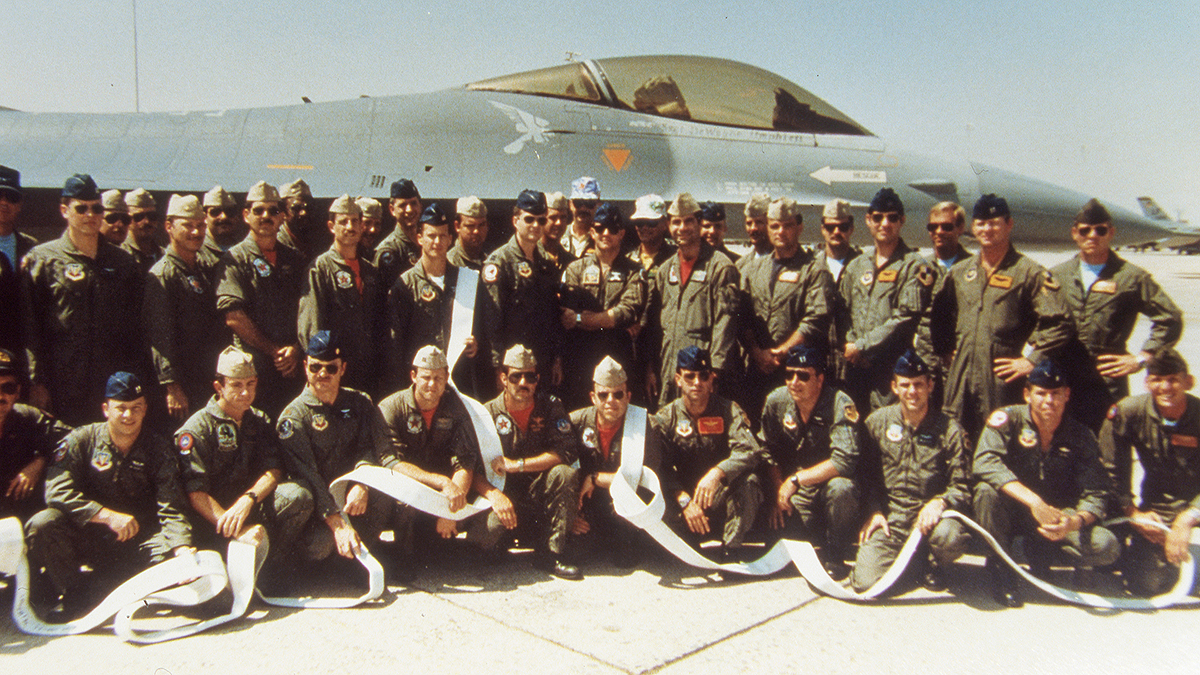
As I recall, due to scheduling at Luke AFB, the first six F-16N qualified instructors flew them with the next Topgun class, while the remaining nine of us flew the A-4s and F-5s. Once that class was complete, the remaining nine Topgun instructors, plus a new instructor, departed for Luke and completed our training there. I had my second F-16D ride at Luke on the 26th of August, and after a morning A-4 flight back to Miramar the next day, I flew my first F-16N flight on the afternoon of 27th August.
The funniest thing that I remember about that flight was sitting on the runway looking through the HUD, advancing the throttle with my left hand, and swatting around all between my knees with my right hand trying to find the stick. I obviously knew that it was on the right console (the F-16 has a sidestick cockpit layout), but having flown the A-4 that morning, I reverted right back to how I had always flown aircraft!
The advantage that our pilots had was that we were all fighter pilots before we got in the F-16. We were also already checked out as adversary pilots. Some had flown the F/A-18 and were very experienced running an air-to-air radar and using the HUD for flying. F-14 pilots, with their Radar Intercept Offers in back, hadn’t. Combining all of these things together, we had a very steep learning curve. We developed a FAM/TAC (familiarization/tactics) syllabus for the F-16N modeled off those already in place for our A-4a and F-5a. For those of us already qualified in the other two aircraft, we abbreviated the syllabus. We obviously still had a great deal to learn about the F-16N, but we were full up and ready to go when the next class arrived.
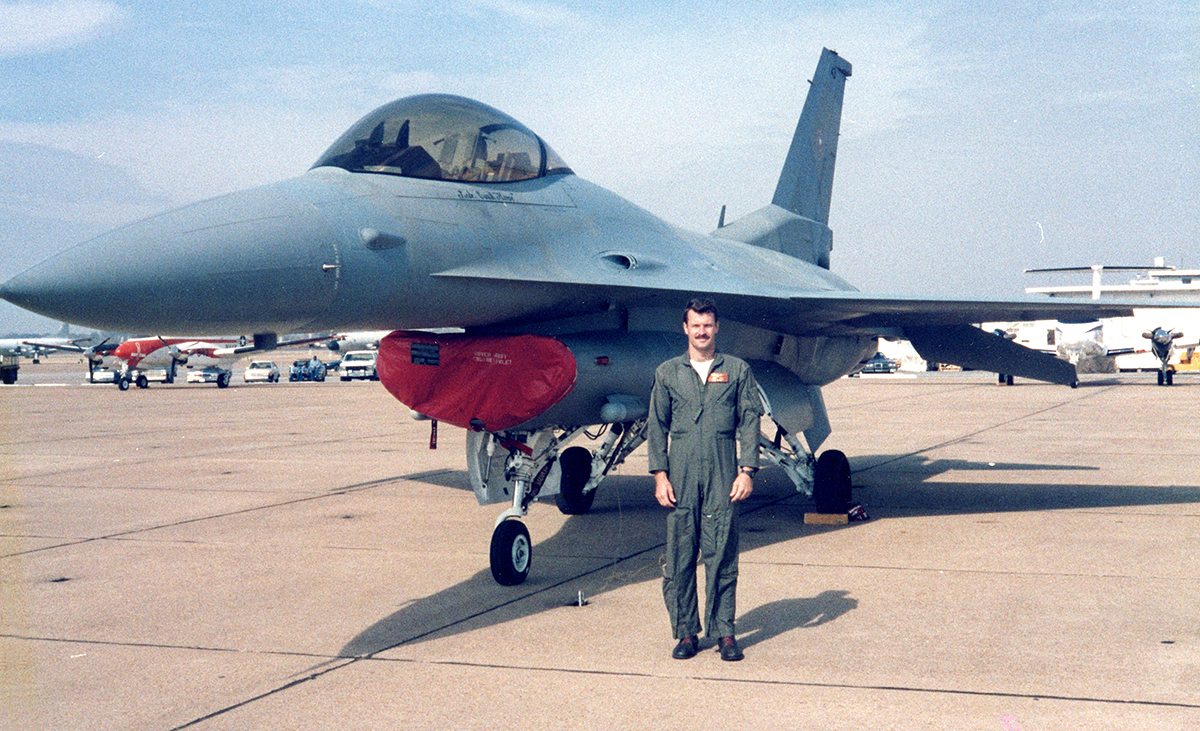
The N was an amazingly powerful jet with a one-to-one plus thrust-to-weight ratio at takeoff. It could take off, pitch straight up, and maintain its airspeed—to a point. Obviously as it got higher and the air got thinner, it would lose performance. But a burner takeoff roll in the N was the next best thing to a catapult shot off a carrier!
In flight it was very responsive in pitch and roll and flew very smoothly. It did have the standard F-16 angle of attack and G limiters set at 30 degrees angle of attack and nine positive Gs. Once you got to one of those limits, it would give you no more. Any aircraft is like that, they can only give you so much. But they’re usually talking to you through things like buffet and wing rock as they approach that point, so you’re more aware that it has no more to give. The F-16 could be flying very smoothly at a slow speed and be at its angle of attack limit and you could pull with all your might, but you weren’t going to move the nose any more as its computerized flight control system limited you from doing so.
We actually had a minor mid-air collision between an N and an F-14 during the first year of flying them, and as I recall the F-16s flight control automation was a contributing factor. The F-16’s wingtip rail grazed the F-14’s trailing-edge flap. Also as with the other F-16 variants, it had an aft center of gravity and fly by wire flight controls to keep it under control in pitch. If you pulled back on the stick, initially the leading edge of the horizontal stabilizers would go down to start the nose of the aircraft pitching up. As you got the desired pitch rate and stopped increasing the pull on the stick, the leading edge of the horizontal stabilizers would actually go up to stop the pitch rate from increasing. We did have the ability to override the computer with a switch, but it was only for use in an emergency situation. Thankfully I never had to use it, however I was once fighting another F-16N whose pilot was required to do so.
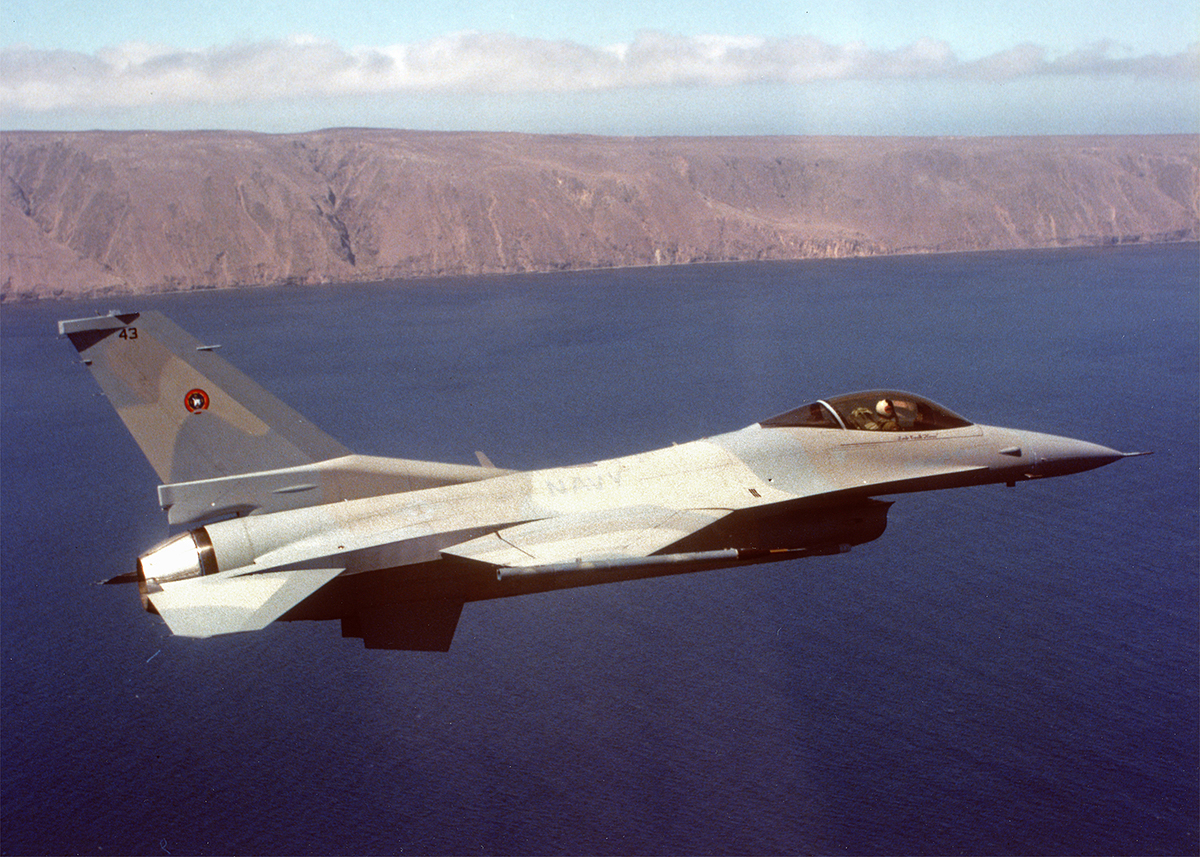
Tactically, the A-4’s performance was very similar to the MiG-17, although not quite as good. In the mid ‘80s, the MiG-17 was definitely no longer a front line Soviet fighter, but it was still operational in many third world countries that we considered threats. The same things could be said for our F-5s that simulated MiG-21s, although there were large numbers of the ‘21s still operational in the world at that time.
The F-5 could also simulate the MiG-23 if it stayed fast and made large arcing turns, and the ‘23 was operational all over the world. However, neither the A-4 or F-5 could properly simulate the fourth generation threats (Mig-29, Su-27 etc). The beauty of the F-16N was that it could simulate all of these threats well if flown properly by the adversary pilot. To simulate the MiG-17 or a similar threat, we simply flew the F-16 full up, except we never used the afterburner. To simulate the MiG-21, we flew it full up, except we would select more than zone two (zone five being the max) afterburner. To simulate the MiG-23 we flew the F-16N at the speed of heat and made no turns greater than about four G. On top of that, we could simulate the fourth generation Soviet fighters, the SU 27 and MIG 29, if we flew it full up, full burner and at any speed.
I think that the arrival of the F-16N finally brought Naval Aviation to the reality that we had truly entered into the fourth generation threat arena. Prior to that time, we didn’t train to a large extent to confront forward-quarter capable threats (shooting down an enemy aircraft from front) because it was difficult to simulate shots, and we generally did not kill-remove fighters during exercises for forward quarter shots by bogeys. Now the adversary aircraft had a recordable radar and HUD which could be viewed in the debrief to validate forward quarter shots. The HUD also allowed instructors to make visual contact with opposing fighters much sooner, and the F-16’s bowless bubble canopy allowed us to maintain it more easily.
Having flown the F-14 and A-4, both of which had multiple canopy bows and items everywhere blocking your outward vision, the visibility from the cockpit of the F-16 was spectacular! The thirty degree recline of the seat was comfortable, and felt very natural. It was supposed to allow the aircrew to withstand the high G forces better, although it did seem to help some in that regard, since your neck was now bent about thirty degrees between your upright head and your reclined body, turning your head and looking aft in under high G forces seemed more difficult. Another nice thing that we had with the N was a Radar Warning Receiver (RWR). This allowed the bogeys to know that their aircraft had been locked up by a fighter radar. When you added up all of these advances that the F-16N brought to the adversary pilot, they truly allowed us to simulate a very capable fourth generation threat, even in the absence of GCI (ground control intercept) radar control for the bogeys and/or the use of an instrumented range.
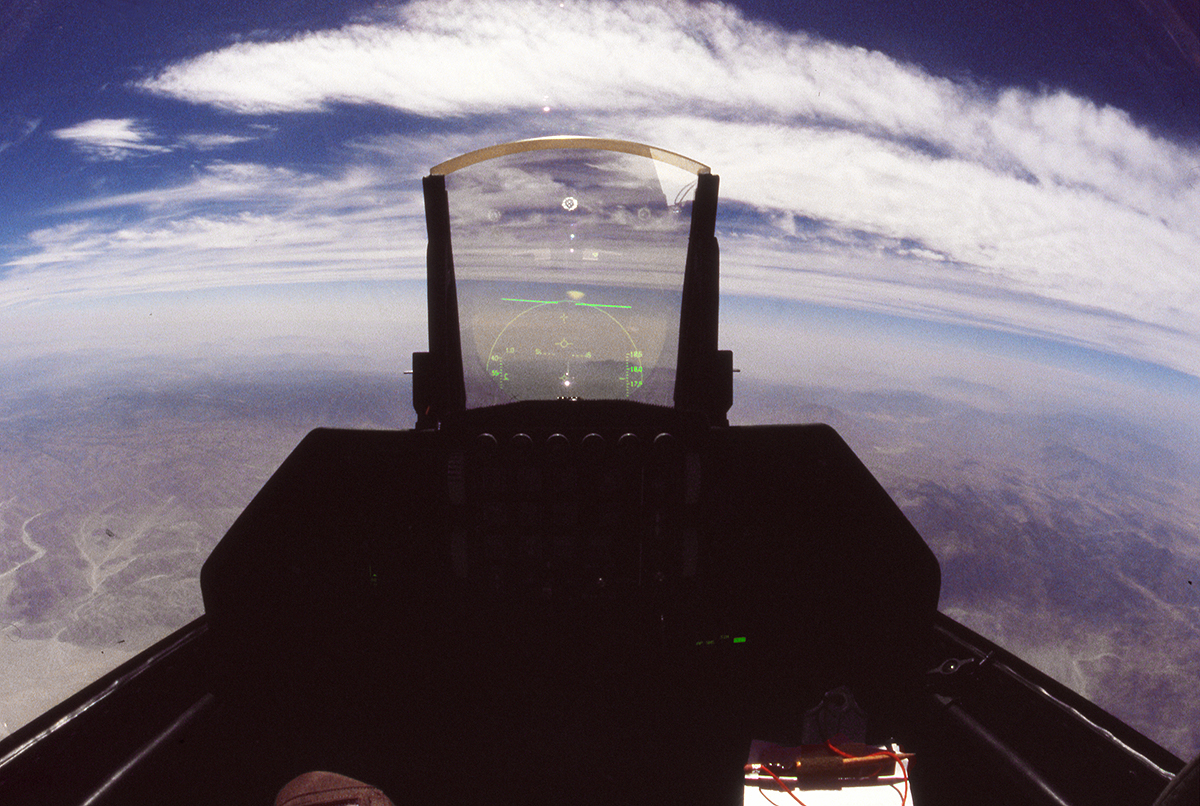
Putting The F-16N To Work At Topgun
Initially the addition of the fourth generation adversary threat was phased in at the end of each phase of the Topgun class. For example, in the 1 V 1 phase, students would still fight simulators of second and third generation fighters early in the phase. However by the end of the phase, we now had the capability of exposing students to a fourth generation dissimilar threat.
Each phase was done in a building block approach, as was the entire course. Normally as students progressed through the class to the latter phases, most flights had some type of scenario as a backdrop, so the students would have an idea of what the threat capabilities might be, and the tactics that they might be likely to use. Early class lectures prepared them in both of these areas. Obviously the further the class progressed, the more likely students would be to see a full up F-16N threat. If we were working with fleet squadrons or the RAG (replacement air group), we could do whatever they needed based upon their training objectives at the time.
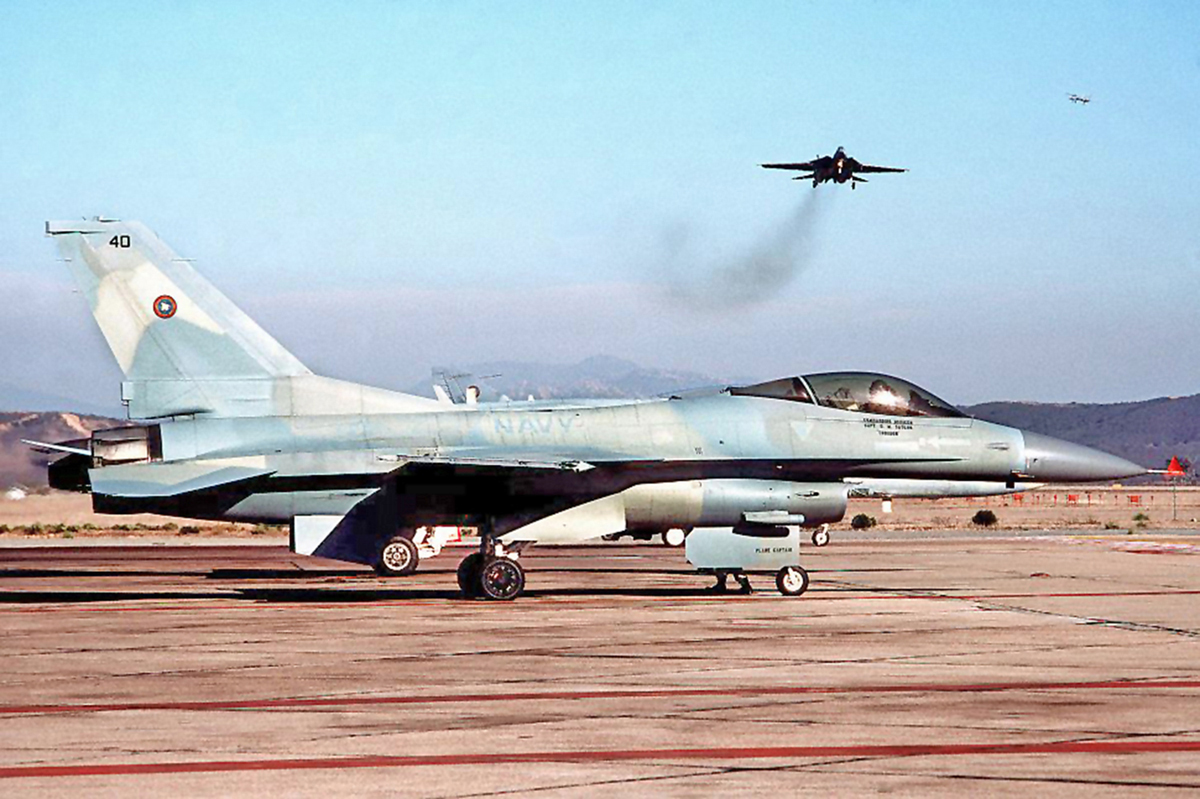
One problem that a fourth generation threat exposed us to was the inability to analyze the forward quarter battle. Instrumented ranges made this much easier, but attempting to do this on non-instrumented ranges was challenging. In the forward-quarter arena, when shots are taken relative to each other, missile flight times and aircraft maneuvering can all play into the difference between a kill, and being killed. Forward quarter shot kill removal had to become a reality, but it needed to be accurate. Consequently following the 1 V 1 phase, we did as much flying on instrumented ranges at Yuma, Fallon, and occasionally Nellis as possible. These ranges could accurately simulate the forward quarter missile shots.
Probably the biggest side benefit for the instructors was that now we no longer simply had to talk the talk, we had to walk the walk. For all but the former F/A-18 and F-15 (exchange) pilots, this was the first time that we had operated an air-to-air radar and practiced tactical intercept communications. With the use of the radar/HUD recorders, we could do a much better job of debriefing ourselves after the fighter debrief was complete. The end result over time, based upon our experiences flying he F-16N, would be changes in what was taught at Topgun and consequently what was put out to the fleet.
We had a total of eight F-16Ns at Topgun. With the departure of the F-5s, we had around seven or eight A-4s, plus we eventually got a TA-4. Normally the F-16s would work in sections of two aircraft. In the larger scenarios, we would normally have a section of F-16s as leaders with a section of A-4s hanging on behind them. If the “Dogs” (A-4s) got separated from the F-16s, they would obviously then become more dependant upon ground radar operator control. It all depended upon the scale of the mission, and the scenario that we were using. However, it was a safe bet that virtually any threat country with fourth generation fighters would be using a section of two aircraft together at a minimum, and we did the same.
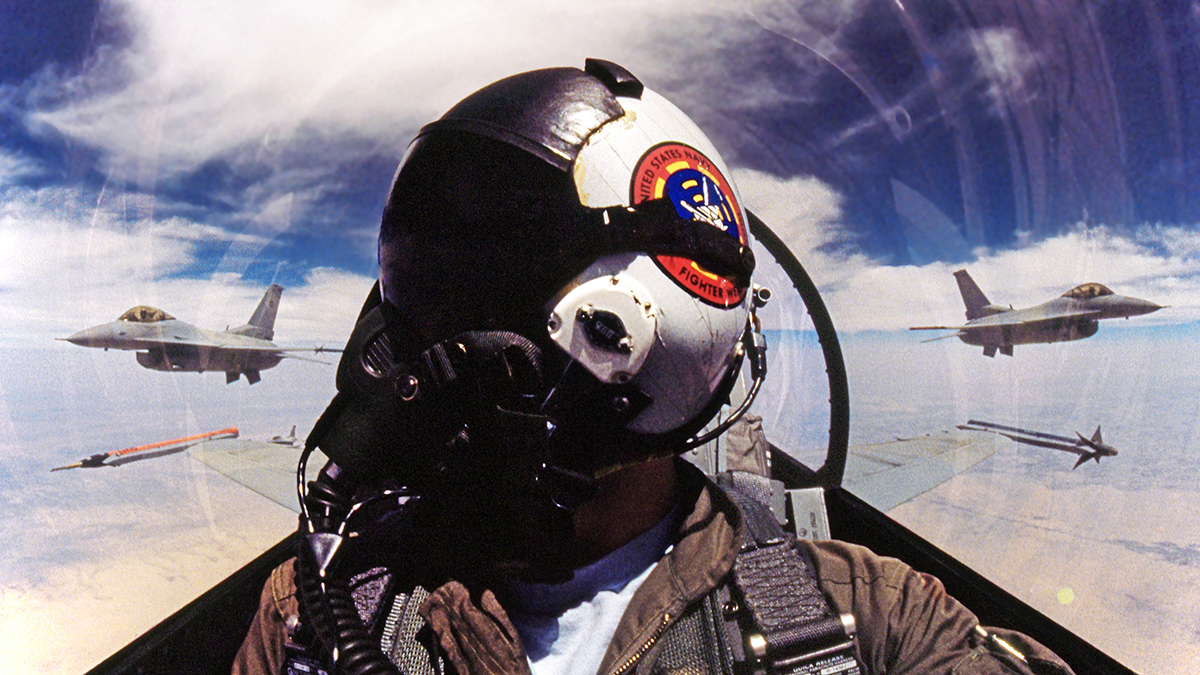
Parrying The Super Nimble F-16N
The F-14’s and F/A-18’s greatest defense against a full-up fourth generation threat was to win the forward quarter battle, and both had the ability to do just that. The F-14, with its two man crew, AWG-9 radar, AIM-54 missile launch-and-leave capability, and AIM- 7 and AIM-9 forward-quarter capable missiles, definitely could excel prior to the merge. Post-merge, short of perfect situational awareness and arriving in a position of advantage over a fourth generation threat, in particular an F-16N, the F-14 did not need to engage in a turning fight. That’s not to say that an F-14 could not win a turning fight with an F-16, but it would require a superior job by the F-14 crew and mistakes by the threat pilot. The F-16N simply enjoyed a significant maneuvering advantage over the Tomcat.
The Hornet also enjoyed outstanding capabilities in the forward quarter, and could also win the battle there. Additionally the Hornet could also turn with most fourth generation threats in a turning fight. The scale could be tipped simply by how the Hornet was configured and how the threat aircraft was configured. A slick Hornet (configured with no external stores) taking on an F-16N was a great fight. Probably the biggest advantage that the Hornet had was the lack of an angle of attack limiter, which the F-16 did have. In a very slow knife fight, the Hornet could achieve a higher angle of attack and slow its down-course speed, flushing the F-16 out in front of it. Obviously this was about the last place a Hornet wanted to be in a true hostile all-aspect weapons capability environment, but in a sterile 1 V 1 engagement, this capability might give the Hornet an advantage. To counter this, the F-16N did not want to get into a slow-speed fight with the Hornet.
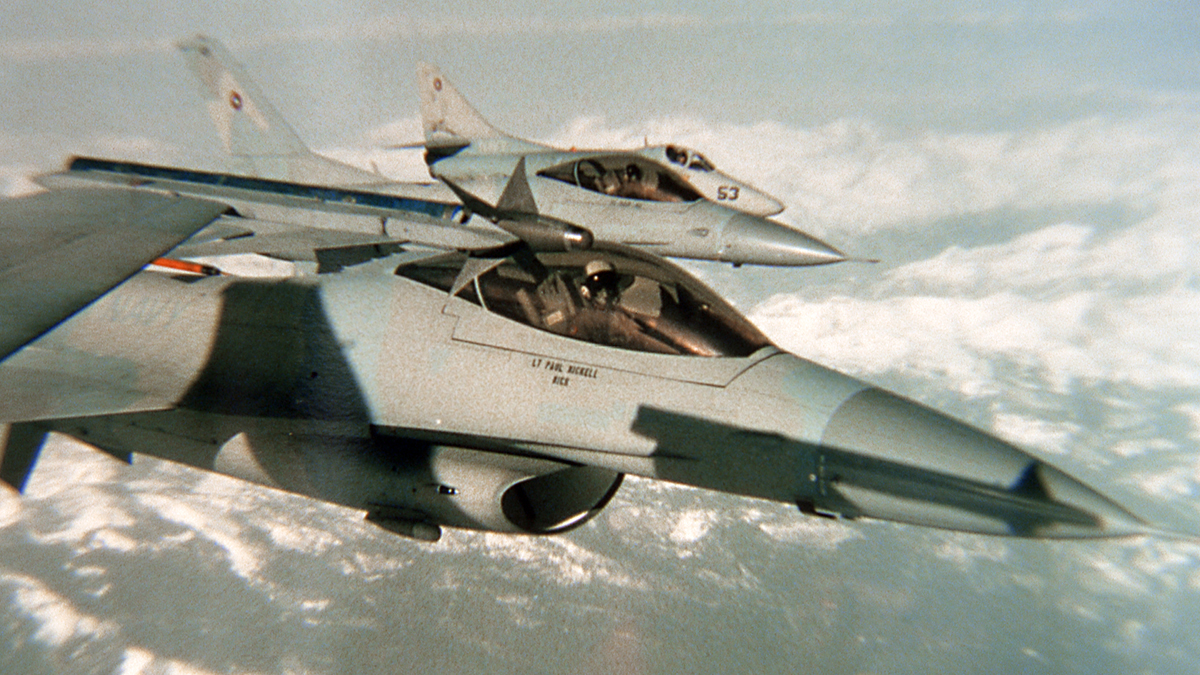
During my time at Topgun, we simulated a variety of threat weapons starting with the basics, the gun. We demonstrated and emphasized how lethal the gun could be even in high-angle off passes in a close in fight. From an air-to-air missile standpoint, we simulated the AA-2 Atoll, AA-7 Apex, AA-8 Aphid, AA-10 Alamo, and the AA-11 Archer. The Atoll and Aphid missiles were close-in and primarily rear quarter infrared (IR) homing missiles, like older Sidewinder variants. The Apex and Alamo were primarily forward quarter simi-active radar guided missiles loosely similar to our AIM-7 Sparrow. With the arrival of the F-16N, we did start simulating the Archer, an all aspect IR missile with off-boresight capability.
Typically this would be part of the loadout when the N was being used to simulate a fourth generation threat. To simulate the Archer, we carried an AIM-9L or M simulator, and used the targeting symbology displayed on the HUD. The seeker could be boresighted or slaved to the radar, for limited off boresight capability. We did not have helmet mounted sights like those Russia had to target their Archer missiles far off their aircraft’s nose during a dogfight. Still, simulating the Archer even without it reinforced the fact that a turning fight with a fourth generation threat could be very deadly.
Prior to my arrival at Topgun, the squadron received its first of a number of successive Air Force exchange pilots. Each was an F-15 pilot and a graduate of the Air Force F-15 Fighter Weapons School. Each was hand selected by the F-15 Fighter Weapons School to serve with us for a two to three year tour. They were all great assets to Topgun, and through them we developed a great rapport with the Weapons School at Nellis AFB.
Usually once a year as both schools’ schedules allowed, we would meet at Nellis or Miramar for an exchange of the latest information and to do a little 1 V 1 flying. During one of these exchanges I remember going out into the SOCAL restricted airspace area in an F-16N with an F-15C. As I recall, most of the engagements ended up relatively neutral… except for one.
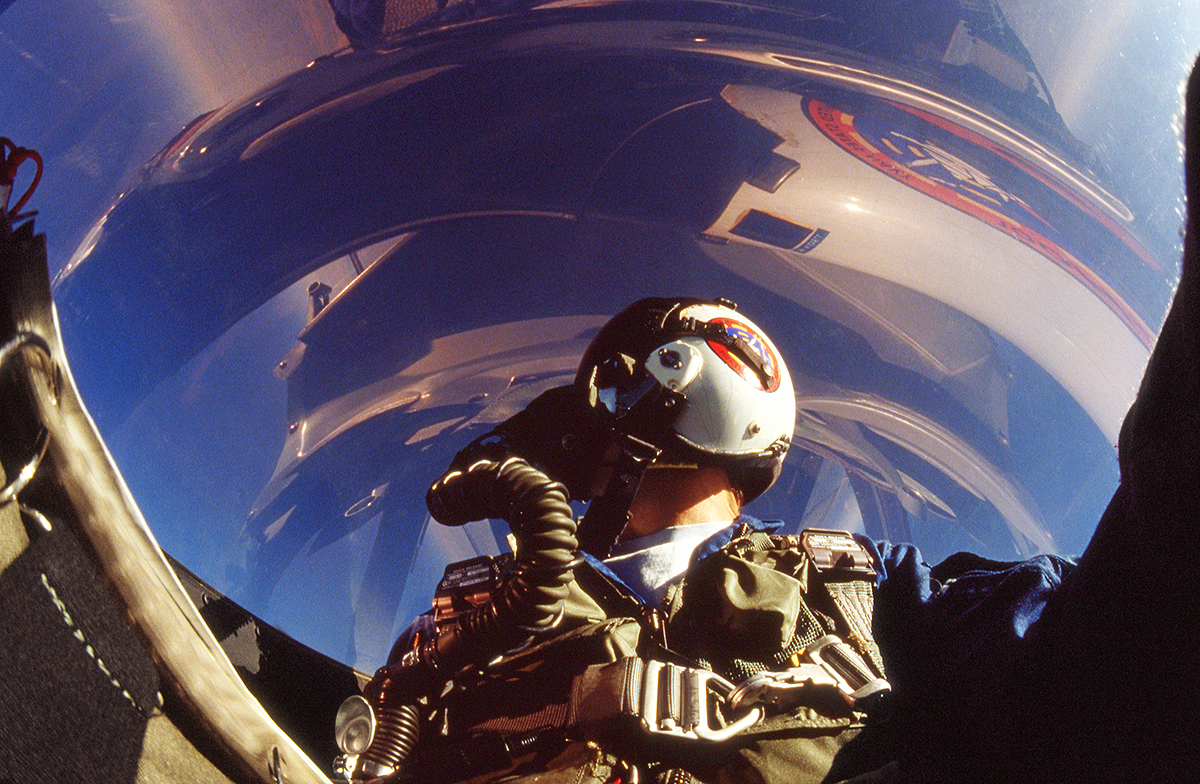
On this particular engagement I, with probably less than 100 hours in the F-16, was rapidly becoming offensive on the F-15, whose FWS instructor pilot probably had 2000 hours in the Eagle. Something was just not adding up, but I accredited it to my superior airmanship, and that was a mistake! He started going vertical and I, slightly in lag, started right up behind him. As we were pointed straight up, I saw this barn door size panel open on the top of his jet (speedbrake) and quickly realized that I had a lot of closure on him. At that point I transitioned to panic and collision avoidance mode. I successfully streaked right past him vertically, and as I did I noticed the barn door closing.
Within a few seconds I had gone from a windscreen full of F-15, to looking back over my shoulder, straight down at him, trapped exactly where he wanted me to be; completely in control, at my six o’clock. He had baited me, and I had taken it hook, line, and sinker. We both had a good laugh about it in the debrief and I’ll bet he’s told that story a hundred times since!
Although we were close with the F-15 FWS guys, we didn’t work with the F-16 FWS guys, even though we were flying F-16s. In the Air Force, the F-16’s mission was to a large extent air-to-ground, or what we considered “Attack” in Navy terms. Since at the time Topgun’s concentration was exclusively on the air-to-air or “Fighter” mission in Navy terms, we worked more closely with the F-15 guys as their mission was the same. For that reason, I never had the opportunity to fly the F-16N against any other variant of the F-16.
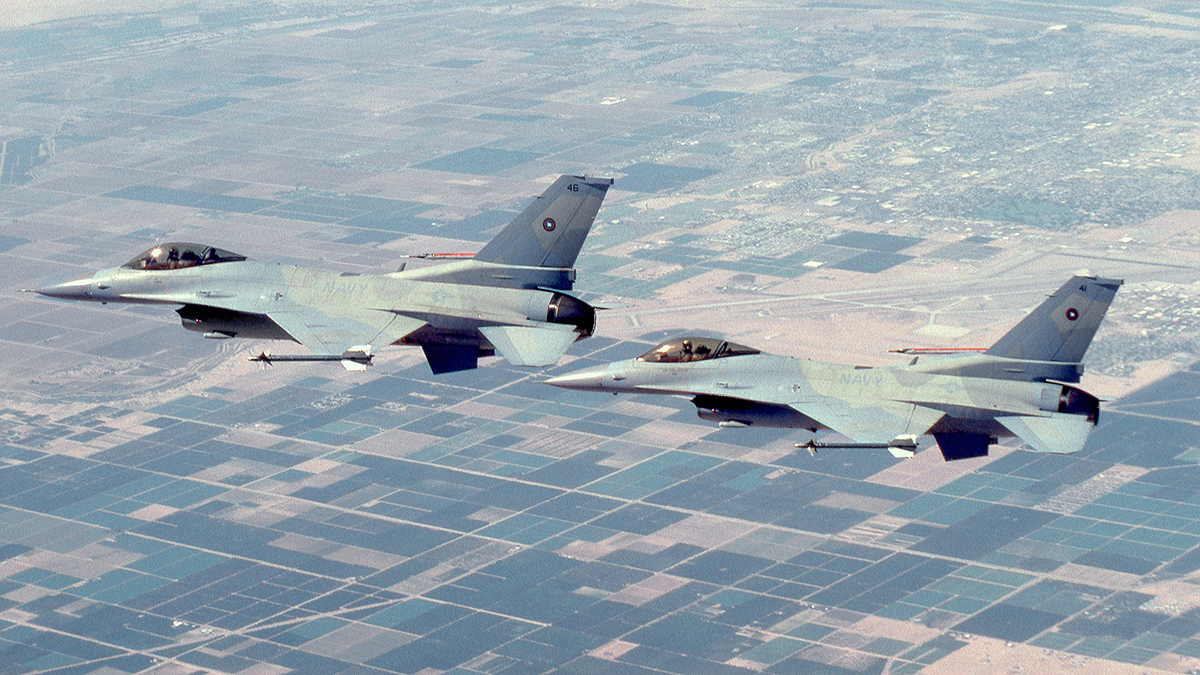
Keeping The F-16N In The Fight
During my time flying the F-16N, it was a very reliable jet. Obviously there are some qualifiers that go along with that statement. It was a brand new aircraft, so the parts still had a great deal of life left in them. Additionally at Topgun we had great maintainers, and we had money and parts support priority to keep the jets flying. I don’t recall ever flying an F-16 with a failed radar. That was a far cry from my F-14 experience. Obviously as time went on, other problems would develop.
I do recall a couple of things early on with the GE engine. One was a type of alert that we could get indicating that the oil quantity could be depleting. I remember my wingman getting this once in the warning area southwest of San Diego. I flew on his wing and we climbed to about 40,000 feet in case the engine seized as we headed back to Miramar. At that altitude he could have flown a flame out approach either into North Island or Miramar if the engine failed. Fortunately it didn’t and once in range of Miramar, we flew a precautionary flame out approach spiraling down to land on Runway 24 Right. It turned out to be a faulty alert.
Another alert dealing with the engine meant that the jet would be down until maintenance could accomplish some type of check. I recall heading east on a Friday afternoon cross country trip and somewhere over New Mexico getting the alert. I was able to get ATC to call our maintenance people and they wanted me to return to Miramar. Fortunately due to the great fuel economy of the jet, I was able to turn around and fly nonstop back to San Diego. After landing I got in a different jet and started the trip again, only about three hours behind schedule.
I also recall a problem in the summer of 1988 that downed all of the aircraft for a short period. I can’t remember if it was structural or engine related, but I do remember all of the N’s sitting in the hangar with their GE F110 engines removed. This was something not too uncommon for a new aircraft model, and it did not last for a long period of time.
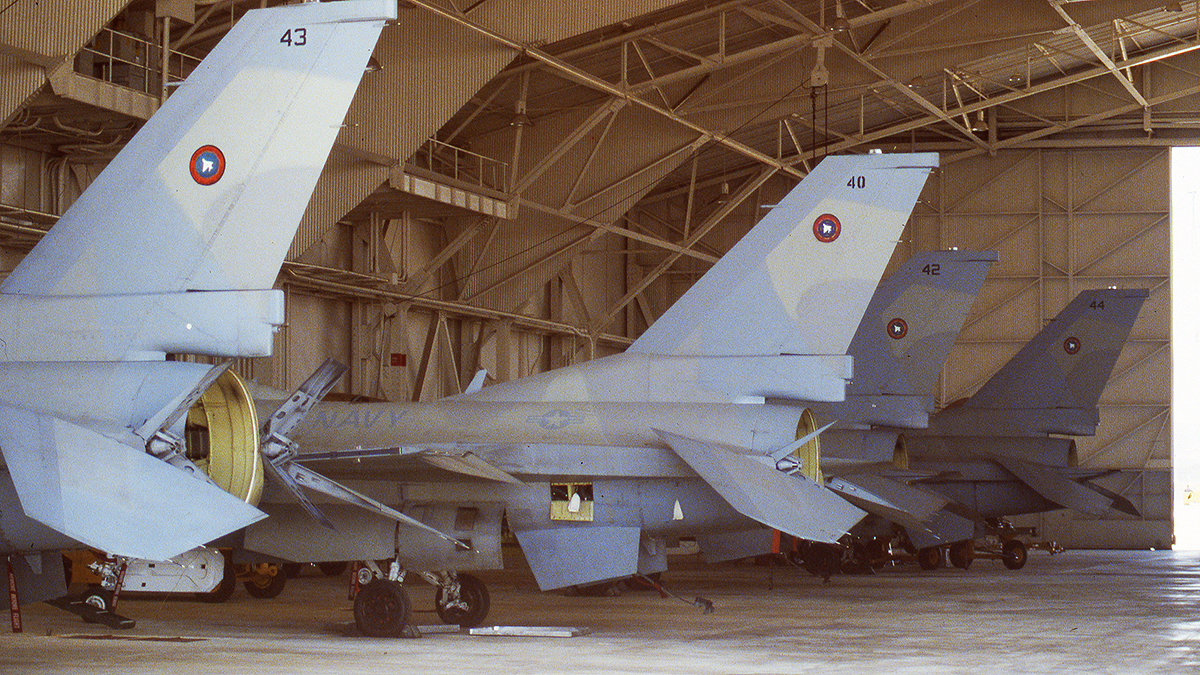
Obviously over time, structural issues did become a problem. I think a large factor in that was the fact that the aircraft had a G limiter, so we felt we could pull as hard as we wanted without damaging the jet. We had all flown jets with G limits, and we had a sense of feel for G forces, but in those previous jets we had been the G limiters. We could pull as much as the jet could give us, and as much as we could physically take, yet we had to personally limit the G load based upon what we were feeling. Not that we were looking at a G readout in a turn, but we did have an indicator in the cockpit that would tell us what G we were pulling and mark the max G pulled until it was reset. At times we would pull too hard, exceed the G limit, and have to write it up and have Maintenance inspect the aircraft.
The bottom line was that we were conscious of the G we were putting on the previous aircraft that we had flown. With the F-16 and its limiter, we weren’t so conscious of the G because we had an element of protection. However, it wasn’t long before we found out that even with the G limiter, we could overstress the jet.
With the rapid onset of G, the aircraft could spike up and exceed the 9 G limit, which would be recorded on the HUD video. Maintenance would then have to use our tape to analyze how many frames of tape the exceedance lasted, which equated to the duration of the overstress. This would be used to determine if an inspection was warranted. The last factor was that the G limiter was for a symmetrical pull. If you are rolling and pulling at the same time, the wing on the side you’re rolling toward experiences less G, and the wing on the side you’re rolling from experiences higher G. The G limiter does not take this into account.

There’s no doubt in my mind that over time these overstresses were what led to the demise of the F-16N. The Air Force flew the jet too and I’m sure that they had the same type of overstresses. The difference was in the missions of the Air Force F-16’s verses the Navy F-16’s and the frequency of overstresses on the N.
Occasionally someone would refer to the F-16 as the “lawn dart.” That name came from a popular game at that time which used nose weighted plastic darts about a foot and a half long that a player would throw at a round plastic loop lying on a lawn. Because of the heavy point, when thrown at the loop the darts would generally pitch down and stick into the ground, hopefully in or near the ring. Unfortunately the F-16 had experienced several accidents early in its life where aircraft at low altitude suddenly and uncontrollably pitched nose-down and impacted the ground. Fortunately the problem had been fixed long before the N came on the scene, however you still heard reference to that name. We generally referred to them as “Vipers” and I think that was the unofficial name used even by Air Force pilots, due to its resemblance of a viper snake. The official name was the “Fighting Falcon.”

Colorful Opponents
The F-16N’s arrived with a factory paint job that was a light grey and blue camo scheme. During my time flying them, that stayed the same, except for one aircraft. I don’t know the origin of the different camo schemes, or who controlled them. Asking some of my old Topgun bros it seems to be somewhat of an unknown, at least in my era at Topgun and the time shortly thereafter.
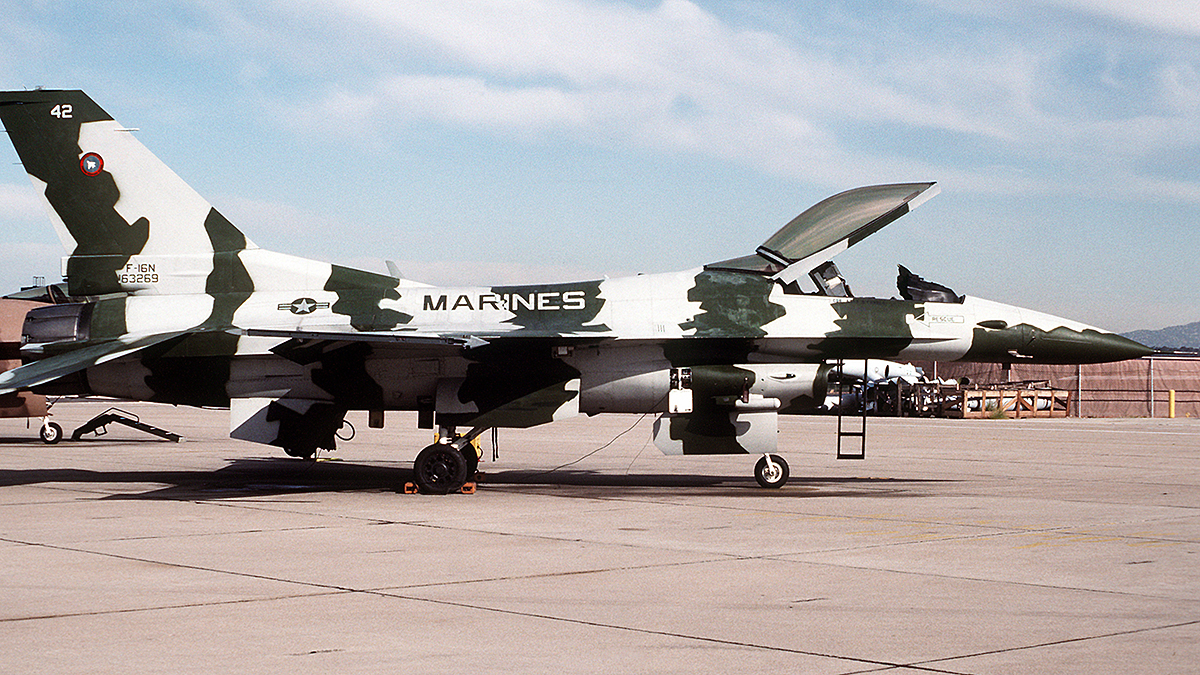
The one aircraft that was painted differently just seems to have appeared that way on the ramp at some point. It was dark green and light green striped, and became known as “The Lizard.” I assume that as time went on and aircraft were due for repainting, various different schemes were used based upon threat country schemes. I don’t know if any of the others ever developed nicknames based upon their paint schemes.
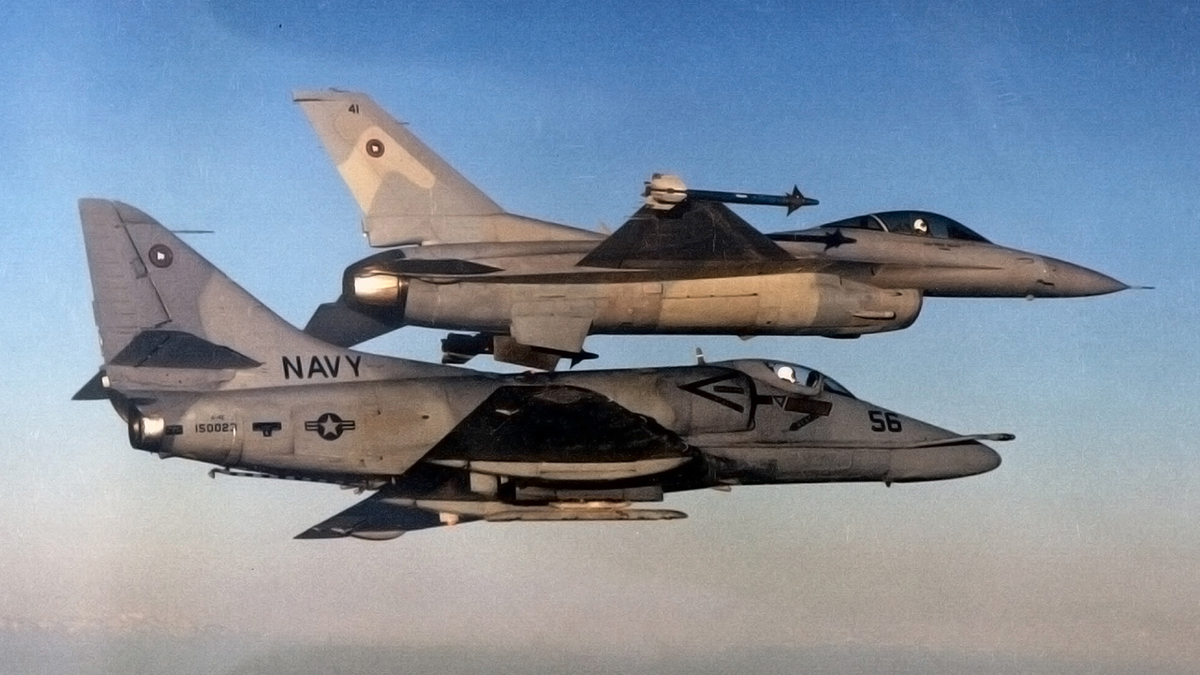
From Vipers Back To Dogs
In early 1988 I spoke to the detailer about my future after Topgun. He told me that I could pretty much go anywhere that I wanted. I told him that I was interested in transitioning to F/A-18 and being stationed at NAS Cecil Field in Florida. His response was, “well I really didn’t mean anywhere.” At that time it was not easy for an F-14 pilot to get orders to the Hornet for his department head sea tour. Within a few years, they were forcing Topgun instructors with previous Tomcat experience to go to Hornet, but timing is everything and I had been extremely lucky with my timing up to this point in the Navy.
I must say that leaving Topgun was one of the most difficult things that I have ever had to do. We had some amazingly gifted and talented instructors, but I was simply a fleet average pilot attempting to do an above average job. I had been honored to be in their company for almost three years, but now it was time to move on.
Leaving active duty late that year, I was very fortunate to stumble upon VFC-885, an augment unit for VFC-13, the Fighting Saints, at Miramar. My last 10-12 months at Topgun were spent as the Training Officer. Even though I had made the decision to pursue a job as an airline pilot, I was so busy with my Topgun responsibilities that I accomplished very little towards securing a job in civilian aviation prior to separating from the Navy. Fortunately a RIO that I knew from VF-24 was very involved with the Reserves at Miramar. He called me a week or two before I left active duty, told me that there was a selection board for Reserve pilots very soon and advised me to fill out the paperwork. I followed his advice, and was fortunate to be selected. I owe him a debt of gratitude! My last day of active duty at Topgun was a Friday, and on Saturday morning I was drilling with the Reserves in VFC-885.
For the next seven months I flew exclusively with VFC-885 while I continued working towards securing a job with a commercial carrier. As an augment unit to VFC-13, a fleet adversary support squadron, the two squadrons operated as one. Administratively, some of us were assigned to one squadron, some to the other, but otherwise no one knew the difference.
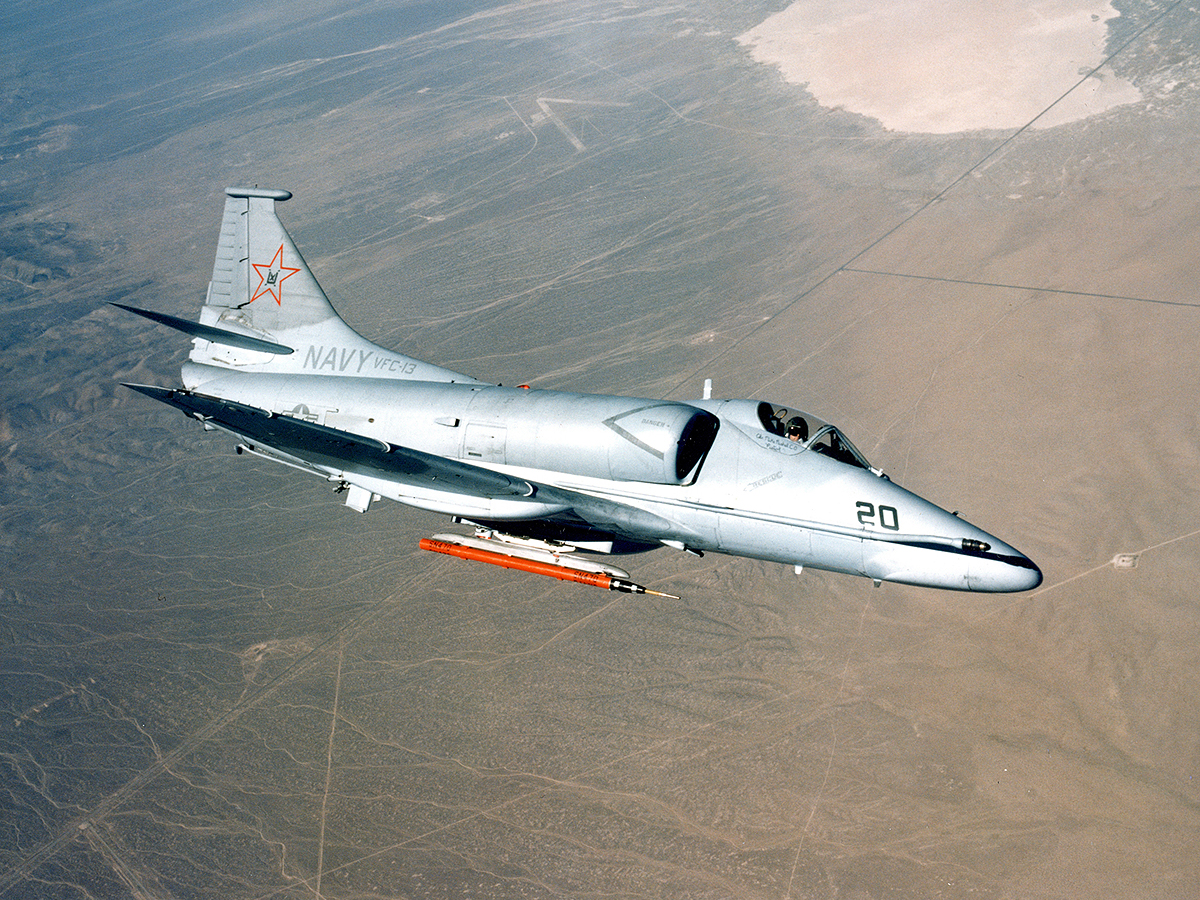
The pilots’ experience levels ranged anywhere from a previous S-3 Viking pilot who was a full time reservist, to former Blue Angel pilots, Topgun instructors and everything in between. Many were graduates of Topgun as either a fighter pilot, or as an adversary pilot. Some had many years of experience flying the A-4 and were extremely proficient at flying and fighting the jet.
We flew the A-4F, otherwise known as the “Super Fox”, and the TA-4J. The Super Fox was more powerful than the A-4Es that I was familiar with from Topgun. It was the only A-4 that I ever flew that required you to pull the power back at times while fighting the aircraft. Prior to that it had always been push the throttle to the stop and leave it there for the duration of the engagement.
Fighting the TA-4 was somewhat of a humbling experience. I mentioned previously that we had ended up with a TA-4 at Topgun, but we never flew it in 1 V 1s because we only had one. I still remember my first 1 V 1 between two TA-4s with the Fighting Saints. We were about a mile abeam and 300 knots when we called “Fights On.” I rolled and pulled with about the same amount of force that I was used to from the E/F model Skyhawk variants I had flown previously and was immediately in heavy buffet. I knew better, but it was what came natural after years of fighting the single seaters. The guy in the back was laughing and shouting “easy!!!, easy!!!” over the intercom. I eventually got used to fighting the “T bird.”
VFC-885’s mission was very different from Topgun’s mission, and my time there allowed me to gradually transition to civilian life. As opposed to training and guiding the fleet, VFC-885’s job was to support the fleet and RAG in any way those squadrons required. They did so in an extremely professional manner. I arrived qualified in the A-4 and was pretty much dove right into the mission from day one at VFC-885.
Walking away from Topgun and the F-16N was extremely difficult, but a part of life. I had become very comfortable with the aircraft and its weapons systems. Although most would think that the sheer power and maneuverability of the jet would be the greatest part of it, I’ll have to say that running the radar and learning to employ the weapons system through the hands on throttle and stick (HOTAS) controls was the most rewarding part of it for me.

Coming from the Tomcat, the ability to operate the radar in every manner, employ all types of weapons, fly the aircraft, and communicate with other aircraft without ever taking your hands off of the throttle and stick was like heaven! On top of that you had the ability to see the radar picture on a multifunction display, and all flight and weapons parameters on the HUD. Thus you had the complete tactical picture displayed directly in front of you. And because you were operating the system, you didn’t have to try to listen to someone else describe the situation.
With time, you not only flew tactically as one with the aircraft, but you also operated and employed the weapons system in the same manner. I had never played the piano, but I eventually felt as if I did while operating the F-16N. It was amazing at times in the debrief to watch the tapes and see what you had done during and engagement, realizing that you had done many of these things without ever consciously thinking about them.
So as I left the F-16N behind, it was back to the basics in the A-4 full time. Loaded up with simulated rear quarter missiles and a gun, we would use reverse bearing and distance calls that the fighters were making and eyeballs out of the cockpit to run intercepts. Locating the giant F-14s usually wasn’t too difficult. If we survived until the merge, then it was time to try to bait the fighters to turn with us and get slow. That was where the A-4 still had a chance; it was back to groveling.

The Early Death And Eventual Rebirth Of The Navy Viper
I know that the F-16N had problems structurally, but its retirement occurred so long after I left Topgun that I don’t have first-hand knowledge of its demise. I do recall that even in its first year and a half of service there was an awareness of structural issues, and we became more conscious of the loads that we were putting on the jet, as opposed to relying on the G limiter. We did start making maintenance write-ups if our G counter on the HUD displayed over nine Gs, and Maintenance would look at our video tapes to determine the appropriate inspection requirements. Topgun had eight of the 26 F-16s the Navy purchased. I’m not sure what was happening at the other squadrons flying the remaining 18 aircraft.
In researching the problem, I’ve come to the realization that all F-16s have had problems with hairline cracks on some of the airframe’s bulkheads. This problem is not unique to the F-16, it occurs in virtually all airframes over time. The F-16 was designed to withstand up to a nine G load with a life of 8,000 flying hours. However by the time the F-16 had been operational for 10 years, a program called Mid-Life Upgrade (MLU) was in place to complete an extensive modernization and add an additional 5,000 hours to its life. As a precursor to the MLU, the airframe was examined and all cracks were repaired. Possibly when GD sold the N to the Navy at a rock bottom price, they planned to make some of the profit back at the MLU point, but I doubt they would have advertised that detail. It’s similar to buying a new car. The dealers don’t make their money on the sale, they make it on maintenance and repair over the life of the vehicle.
From an engineering standpoint, it’s advertised that the lower wing attachment points of the N were made stronger to withstand the higher expected rates of heavy G. Is it possible that by strengthening the weakest link in the structure, a new weakest link was created elsewhere, and one that might be much more difficult and expensive to repair than the previous weak link. I don’t know the answer to that question. I’m sure that the decision to retire the jet was based upon economics. I doubt that anyone wanted to see such a capable dissimilar adversary aircraft disappear, but ultimately someone had to pay the repair bill. Obviously the money that had been saved on the purchase of the aircraft had not been placed in an “F-16N maintenance trust”.
The Navy did reacquire the F-16 less than a decade after the N’s retirement, although not buy ordering them new from the factory. These jets came from a lot of embargoed F-16s that were built for Pakistan. The good news is that when the Naval Strike and Air Warfare Center (NSAWC) received the aircraft in the 2002/03 timeframe, the airframes had virtually zero time on them.
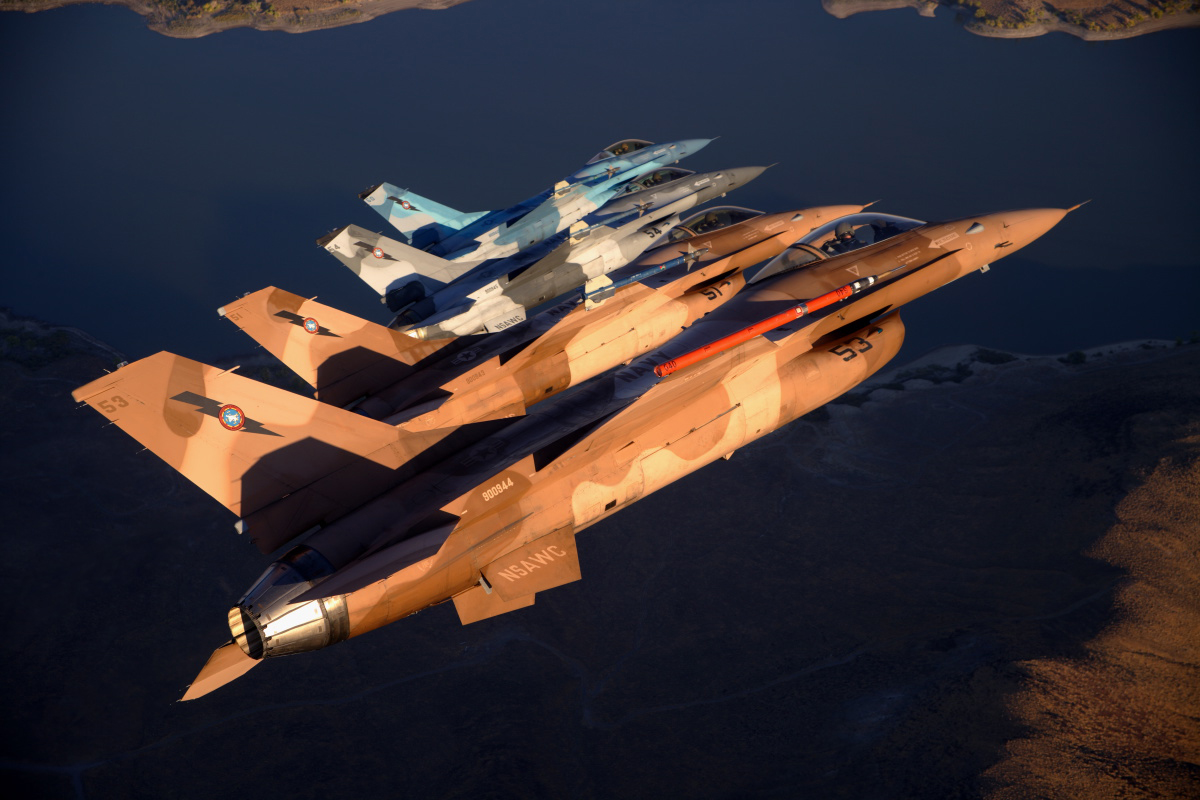
In comparison to the N, these aircraft have the Pratt & Whitney F100-PW-220 engine with about 2000 pounds less thrust than the N’s GEs F110 engines. Of the Pratts, it was the more reliable of the early model F-16 engines. The radar should be the same as what we had on the N, the APG-66. For Hornet pilots I’m sure it is a step down, but at least in the mid ‘80s, it was sufficient for our mission.
Unless removed, I assume the aircraft have the cannon and ammo feed system, adding around 350 pounds of weight, but eliminating the requirement for ballast weight in the nose. Most likely these aircraft do not have the strengthened wing… and maybe that’s a good thing. Overall, I surely would not pass up these aircraft. I would say that they are very close to what we had with the F-16N, with the biggest difference being 2000 pounds of thrust. Personally, of all of the differences, I would place the thrust difference at the bottom of the priority list. For 1 V 1 scenarios that bit of thrust might be important, but for the vast majority of NSAWC’s missions, I think it’s negligible.
It appears that since the embargo has been lifted against Pakistan, they now want the 28 jets delivered that they paid for but never received. Fourteen went to the Air Force, and fourteen went to the Navy at NSAWC. My understanding is that both services were told to return the aircraft for delivery to Pakistan, but so far only the Air Force has begun to do so. The Navy has managed to hang on to theirs and keep them flying.
I have to laugh about that. Even though the command or squadron of Topgun no longer exists, the spirit still lives with those running the class and mission at NSAWC. From the beginning of Topgun, it was lie, cheat, and steal; do whatever you had to do to get what you need and make it work for the organization, and ultimately the fleet. My guess is that the Navy will finally surrender the F-16s when they have zero hours left on the airframes, and then bill Pakistan for the cost of maintenance for all of these years!
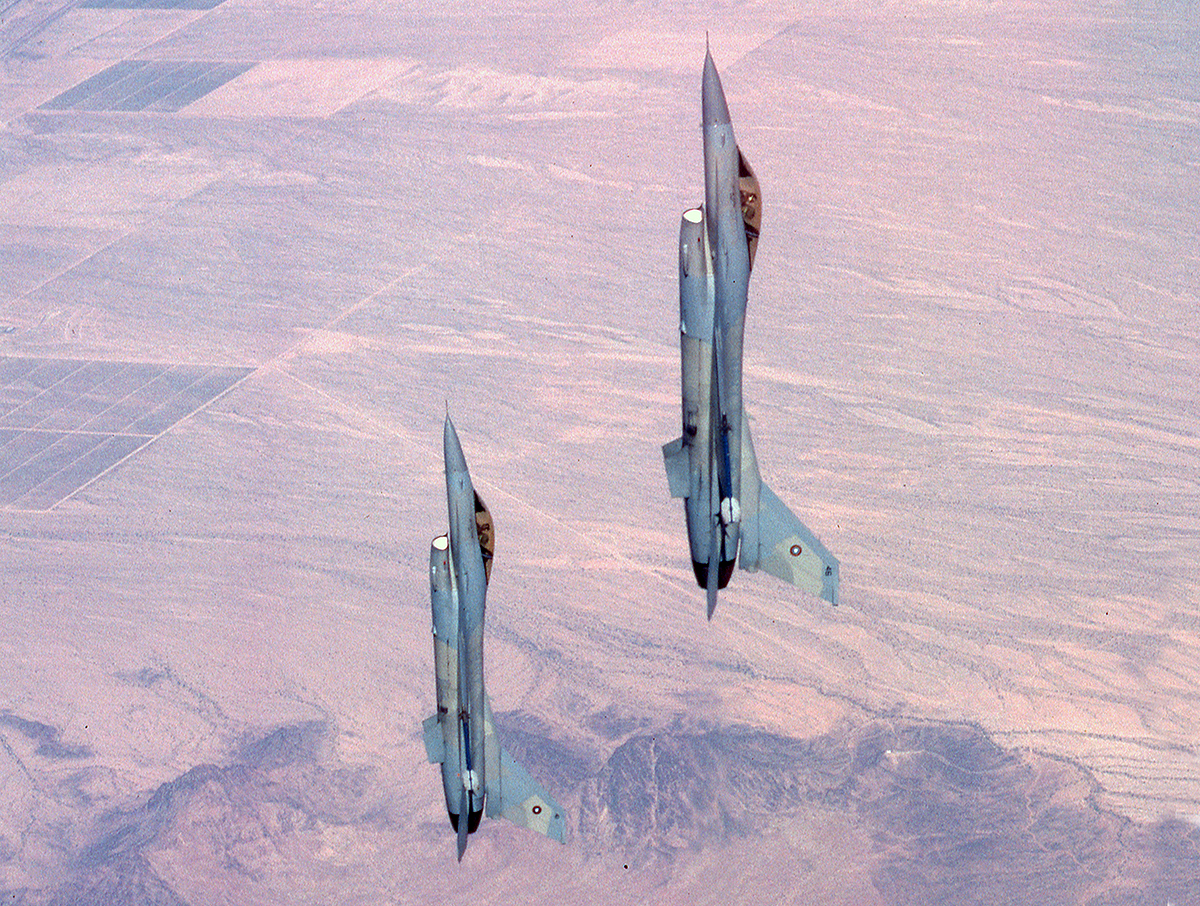
Memorable Moments In The Hottest F-16 On The Planet
We were at Naval Air Station Fallon between Topgun classes, in support of Air Wing training. After the F-16’s arrived, our services were in constant demand because everyone wanted exposure to the fourth generation threat. At times this stretched us very thin, and we often anguished and battled it out in staff meetings as we attempted to prioritize what we could support and what we could not.
On one particular night it was another instructor and I each flying F-16Ns. We provided adversary support for several Air Wing night strike missions, and then we were done. We had lots of gas remaining and started heading back to Fallon.
There happened to be a restricted target area, R-4804, about 20 miles from the runway and we asked if anyone was using it. No one was, so we meandered into it. It was a beautifully clear night with a full moon. There was a lot of snow on the mountains and it was almost like daytime with so much moonlight reflecting off the snow cliffs. Before you know it, one of us lights the burner and starts turning in, a move which was quickly reciprocated by the other. Rapidly we end up across the circle from each other in somewhat of a lufbery, with neither of us being aggressive, just taking in the beauty of it all.
Long light-blue burner plumes were visible against the deep blue night sky with the moon acting almost as the sun above. Then one of us started going more vertical and pretty soon we were across the circle from each other doing loops. At times we were looking at the other against the deep blue heavens above, and at times against the brilliant white snow on the earth below. This lasted for several minutes of time above the earth that night, but the beauty of it is etched in my brain forever.
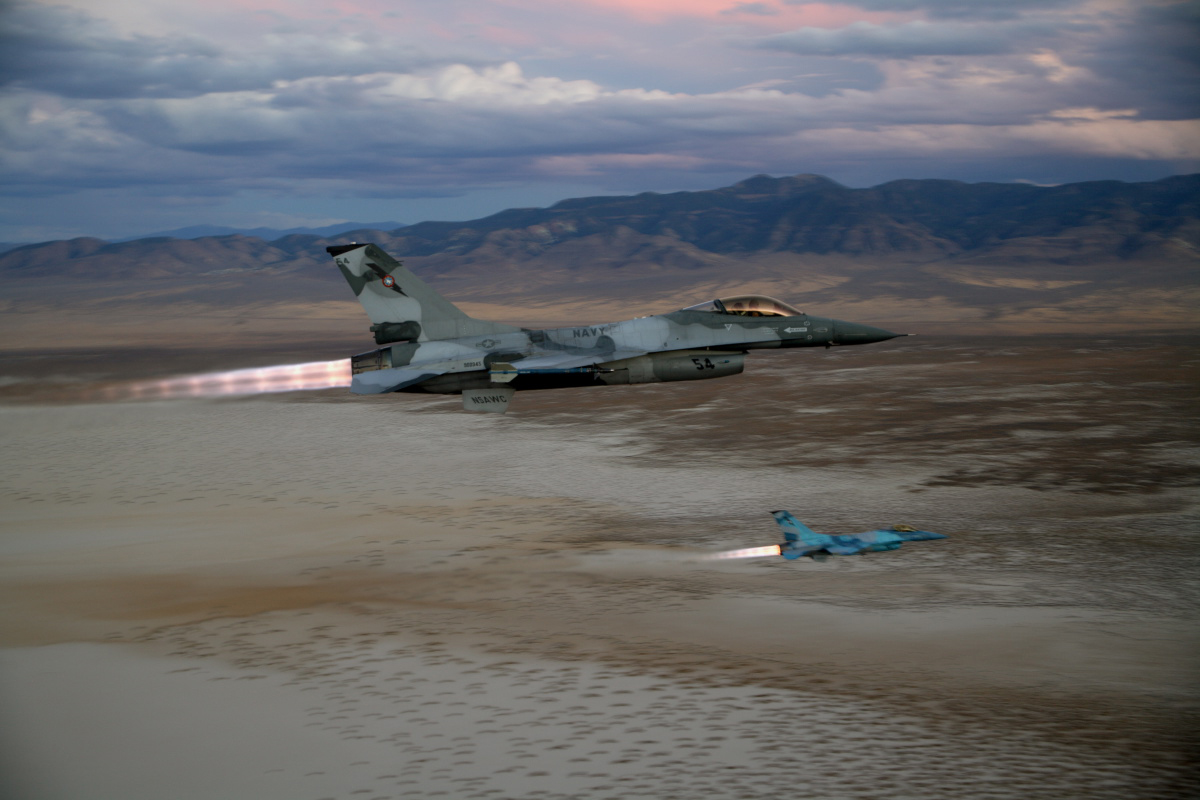
Another time that stands out was one of my last Topgun class graduation exercises. The target was an enemy airfield in R-4804. I was in the lead section of bogeys, two F-16N’s, and we had a section of A-4’s dragging along behind us. Initially we were holding over the enemy airfield, and then we got the call that radar showed fighters inbound. We did another quick circle around over the airfield simulating the reaction and launch time for enemy bogeys from the airfield, and then took a vector for the inbound fighters.
We pushed it up to about 450 knots, hoping the Dogs could hang with us. Almost immediately we had the fighters on the radar. Each F-16 pilot called his contacts, with the lead having a flight of two, line abreast, at about 20,000 feet, and the wing having a flight of two about five miles in trail of the lead section, and offset right at about 15,000 feet.
I locked one of their lead section jets and my wingman locked one of the jets in the trail section. Our communications were very clear and concise with every call acknowledged. Beyond that there was a good bit of silence during the intercept, with the Dogs in tow behind us silent the entire time. They were simply listening to the comms between the Viper pilots and building their situational awareness from it.
Approaching ten miles head-on, I took a simulated Alamo missile shot on the lead section of fighters. Within a few seconds, I was told by the range controller that I was dead. Oh well! That meant my shot went stupid, and that would probably be it for me for the day. I did the standard kill removal procedure for being shot in the forward quarter. I went to full burner, stood the jet on the tail, and started doing aileron rolls going straight up. This would identify me visually to the fighters so that they would not pursue me any longer.
During that maneuver I topped out somewhere close to 35,000 feet, then rolled and headed back toward the bogey airfield. To simulate the reality of larger numbers of bogeys, I could come back to life, but I would have to fly back to my home airfield (the target) before I could regenerate. I bolted that way and arrived just after the strike package had exited the target area. By the time the range controllers gave me a vector, the good guys were well out of range and home free. I joined back up with the rest of the bogeys and we did some low-altitude intercepts, raging around in the valleys between the mountain ranges until we got to bingo fuel, and then headed back to Fallon.
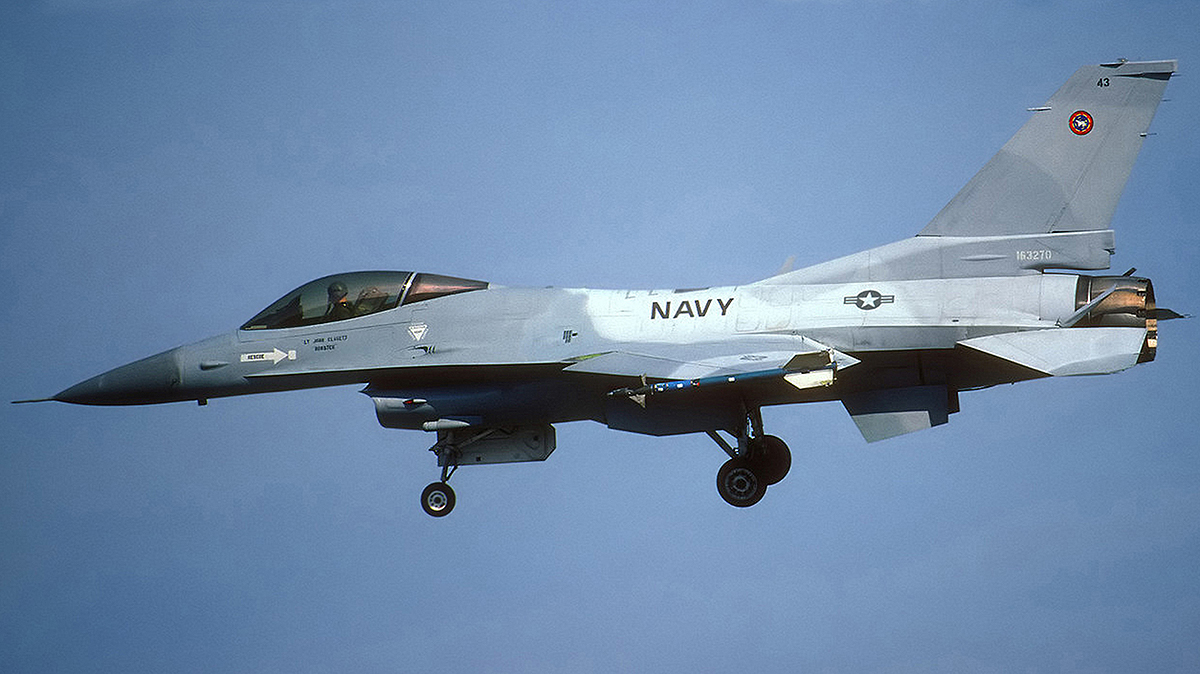
Before the class debrief, we did a quick bogey debrief with everyone describing what they had seen during the scenario. My comments were obviously very short. Then the Dog driver that was in trail of me spoke. He picked it up with our initial vector and then talked about listening to the communications of the two F-16 pilots running the intercept. As he flew along simply listening, he felt as if he had perfect situational awareness as to what to expect when the flight merged with the fighters.
He then went on to talk about me being shot, and the kill removing maneuver I executed. As I pulled into the vertical and started doing aileron rolls, he flew right under me. He described how he watched as I pulled the F-16N vertical and went straight up, virtually disappearing into the deep blue sky above. He was mesmerized by what he saw.
As I sat and listened to his recap, two things came to mind. First, the F-16N had finally allowed our staff to practice what we preached, and to build upon our syllabus based on our experiences flying and fighting this awesome fourth generation jet. Second, it made me realize the amazing power of the F-16N, and how blessed I had been to have the opportunity to fly it. Again, this was probably not the flight that most people would think would be my most memorable. However, as my F-16N time was waning, it was a time of reflection for me on just how far we had come as a staff since the arrival of the F-16N.
Some outsiders believed that we were a group of arrogant pilots who lived to win. The reality was that this might be true, but you had to determine what constituted winning. We definitely were arrogant about training the best fighter pilots in the world. If we did our jobs well, we went out and lost to those fleet fighter pilots, dying at their hands on a daily basis. In some ways we couldn’t lose. If the fighters did poorly, we could win an engagement, but if the fighters did well and killed us, we truly won in the sense of the big picture and our mission.
Such was the life of an adversary pilot and Topgun Instructor…
Contact the author at tyler@thedrive.com
